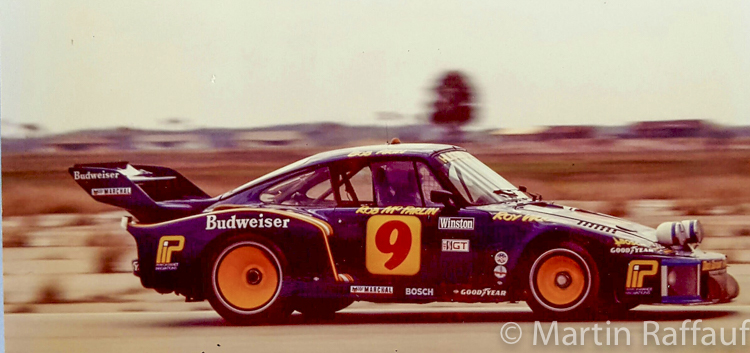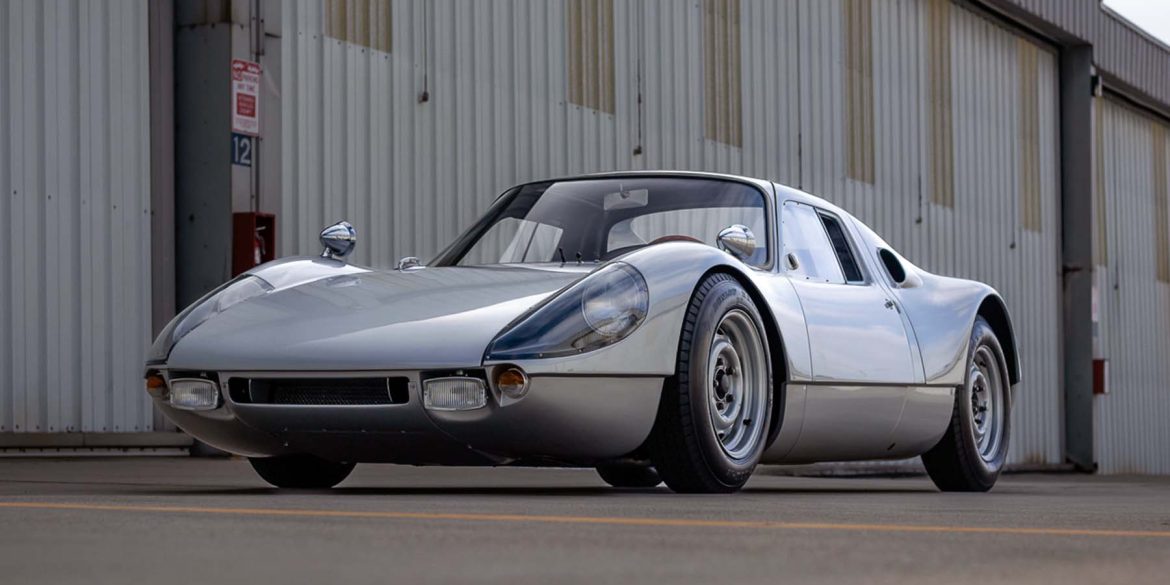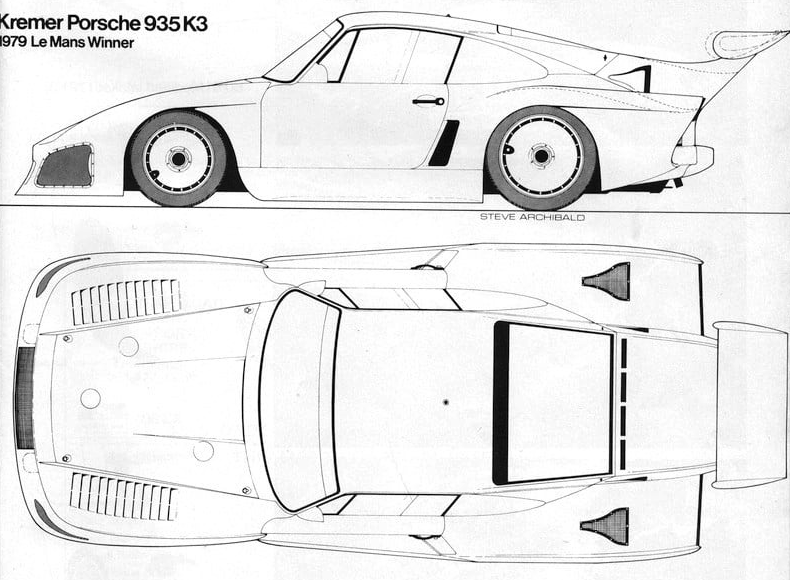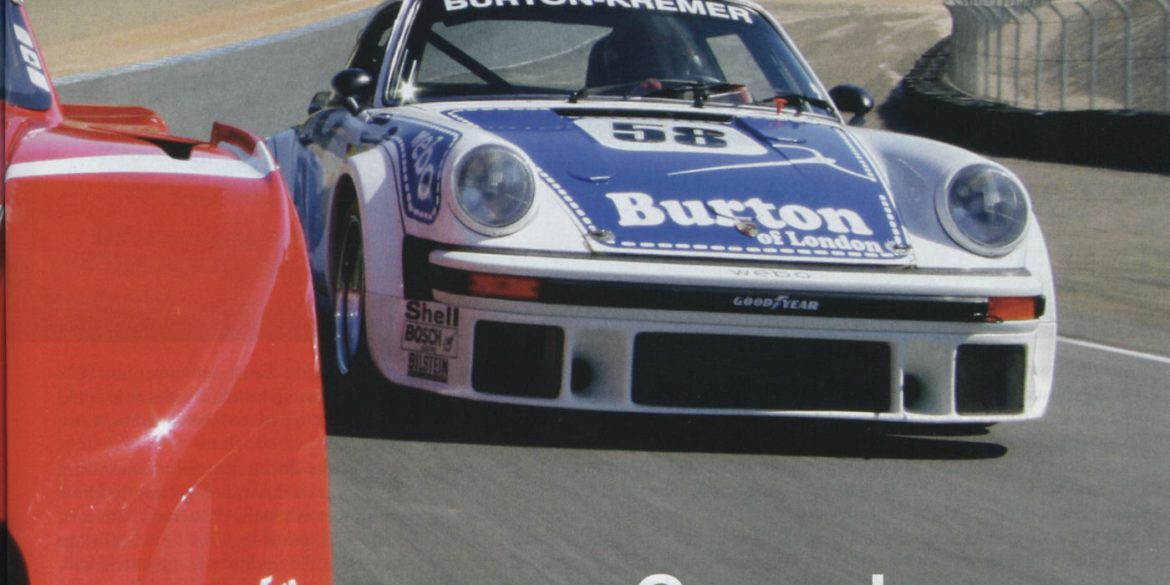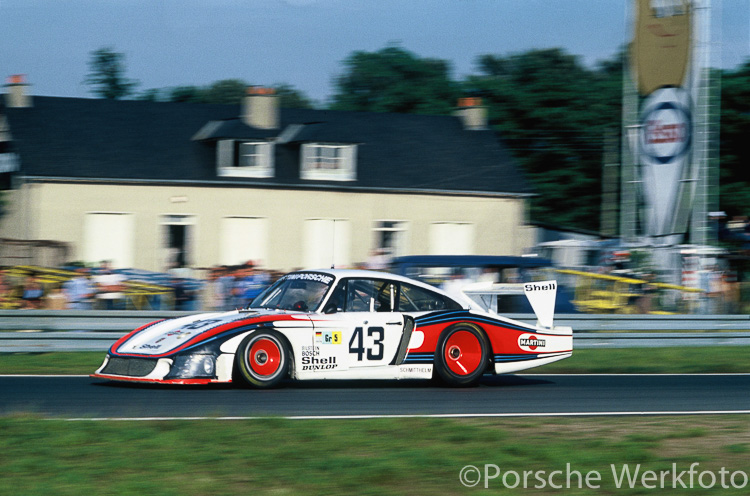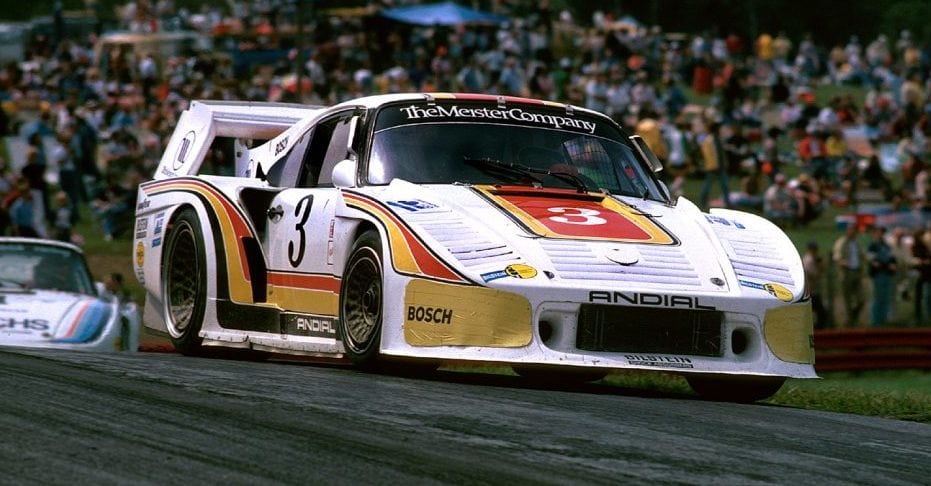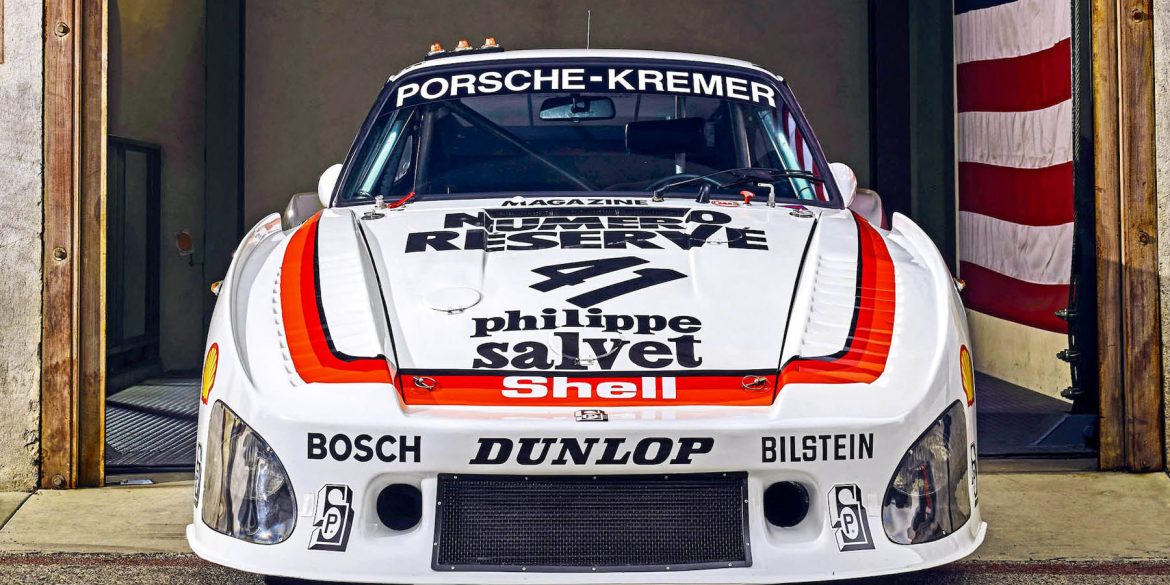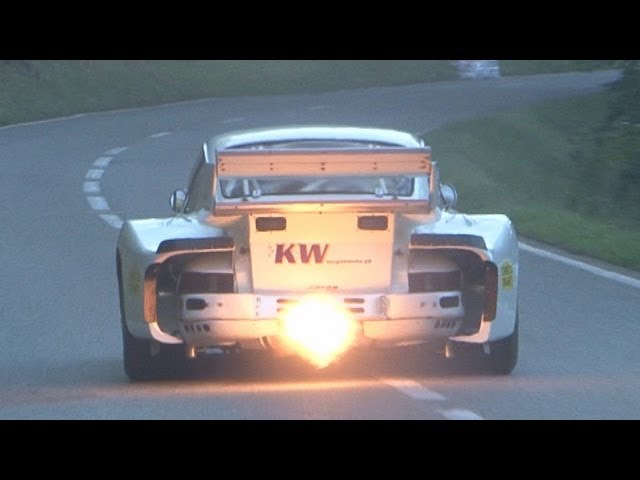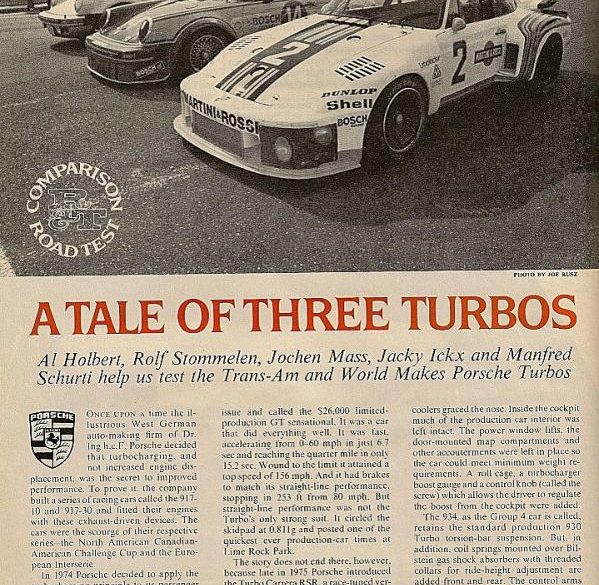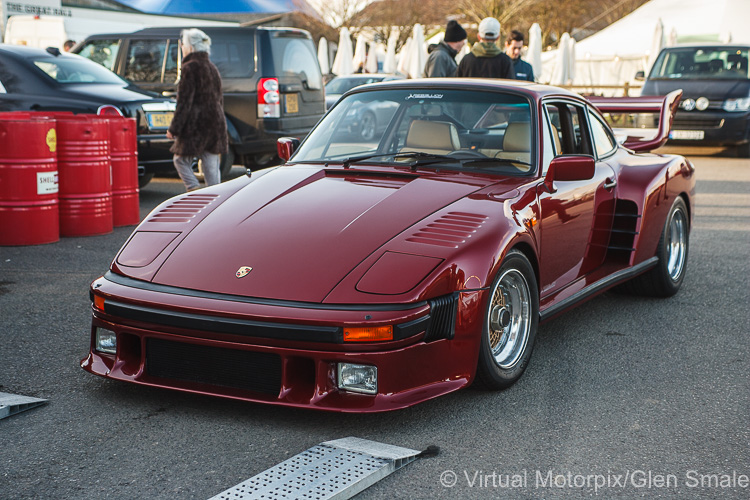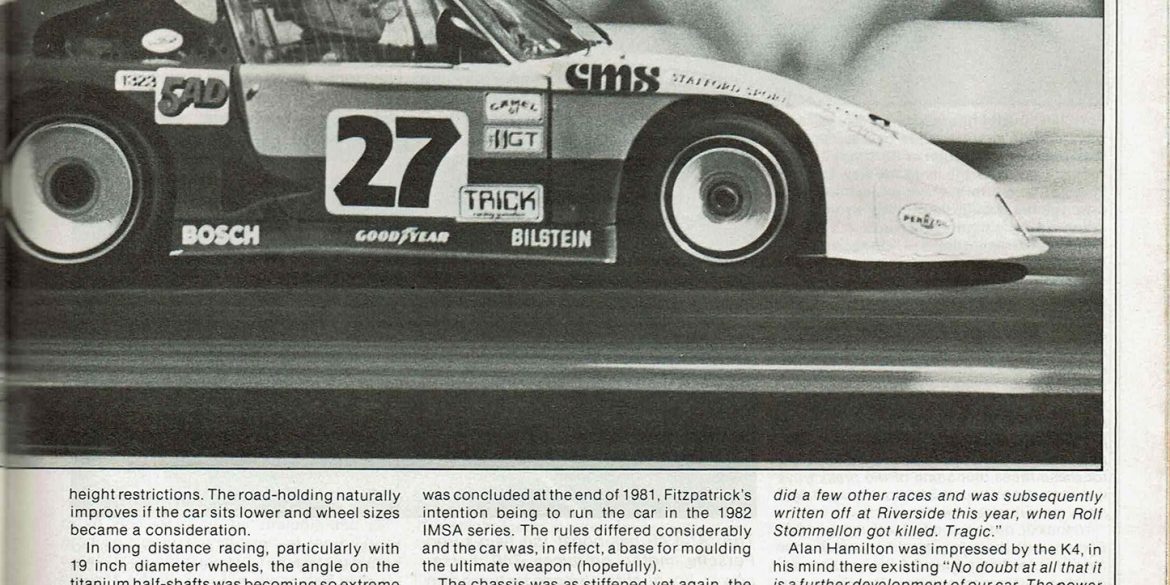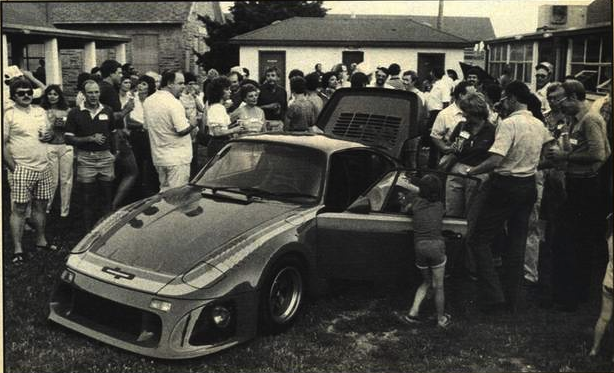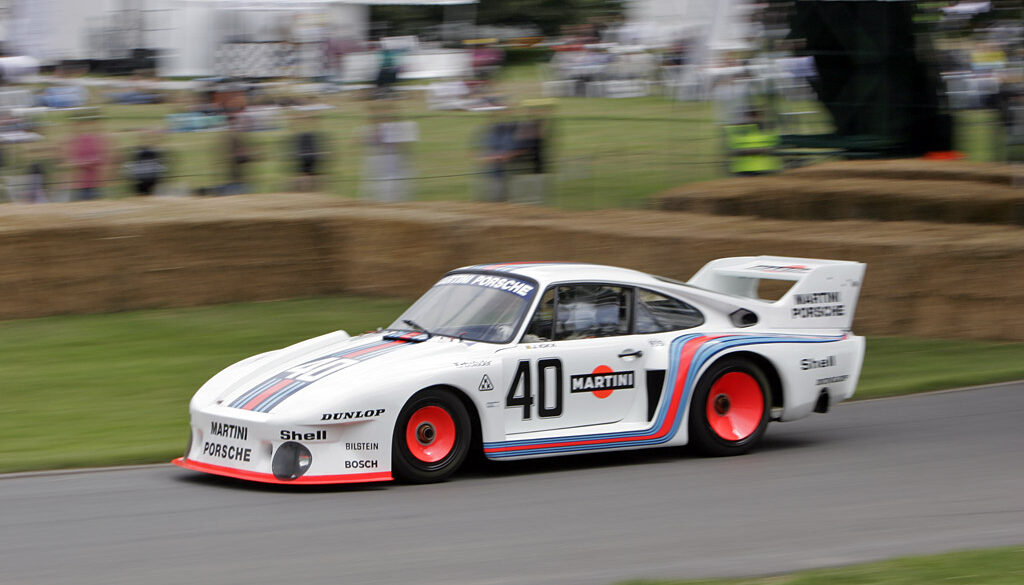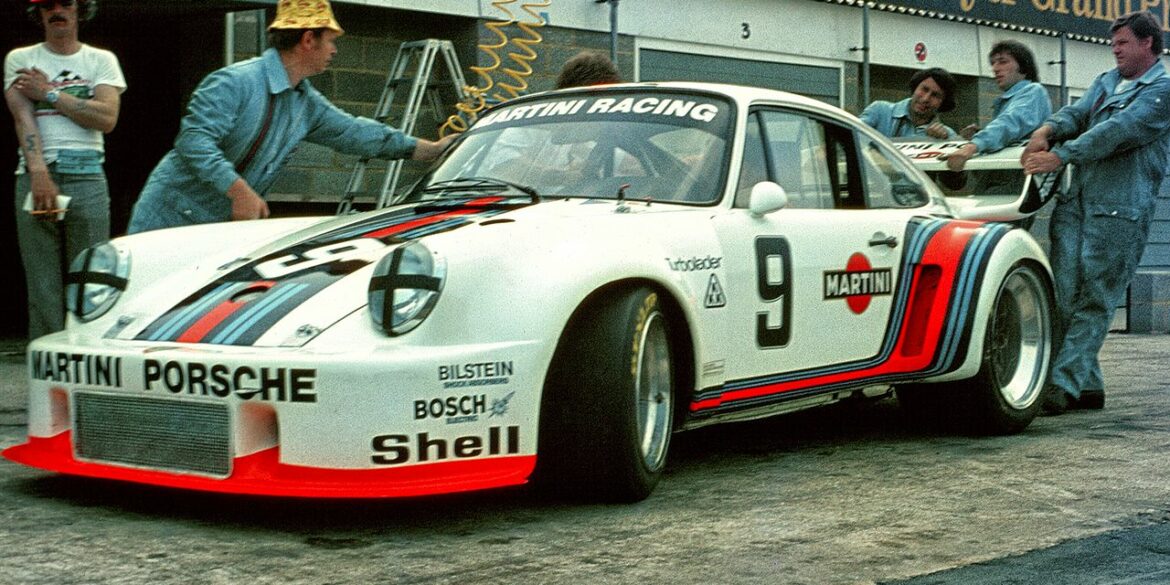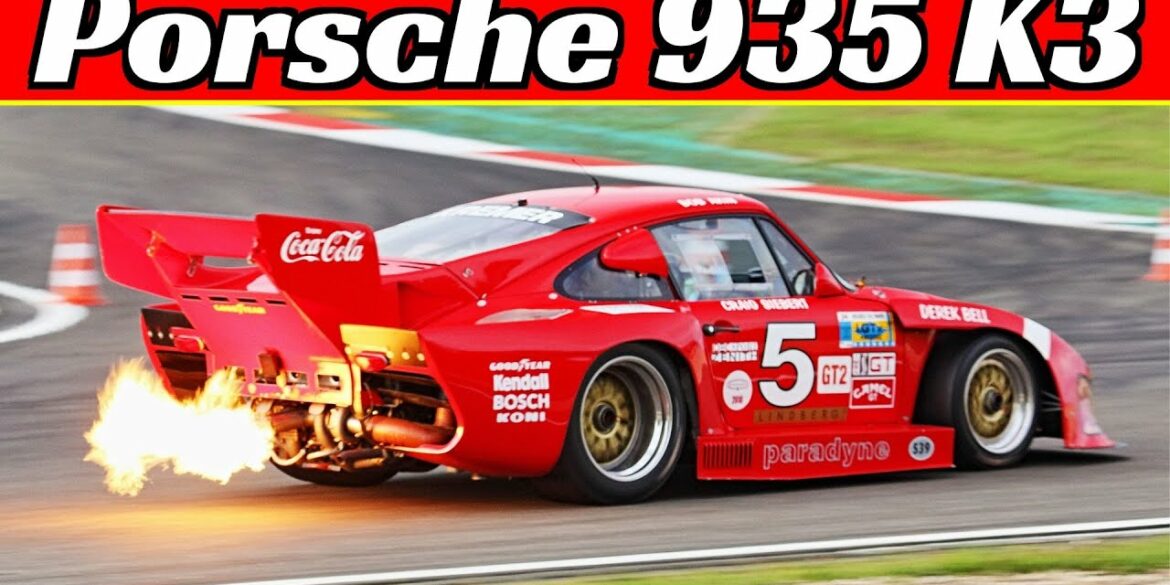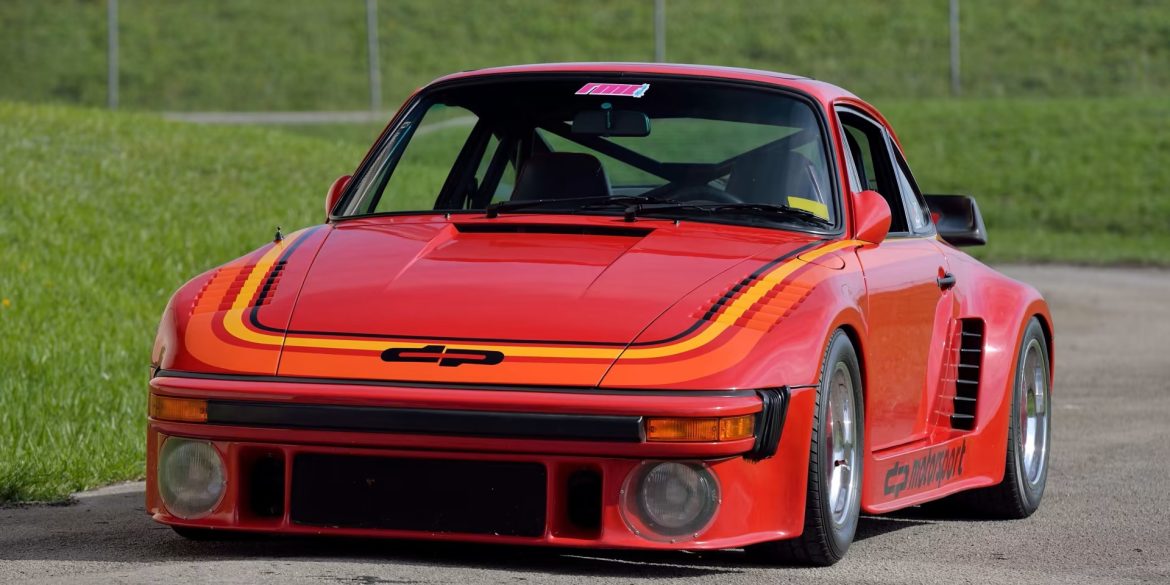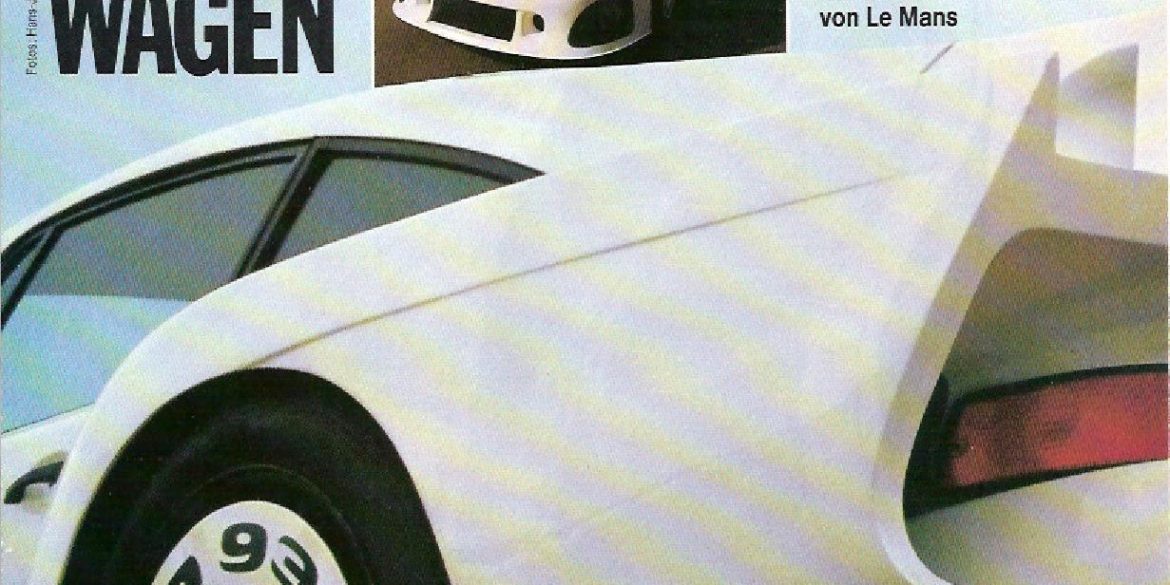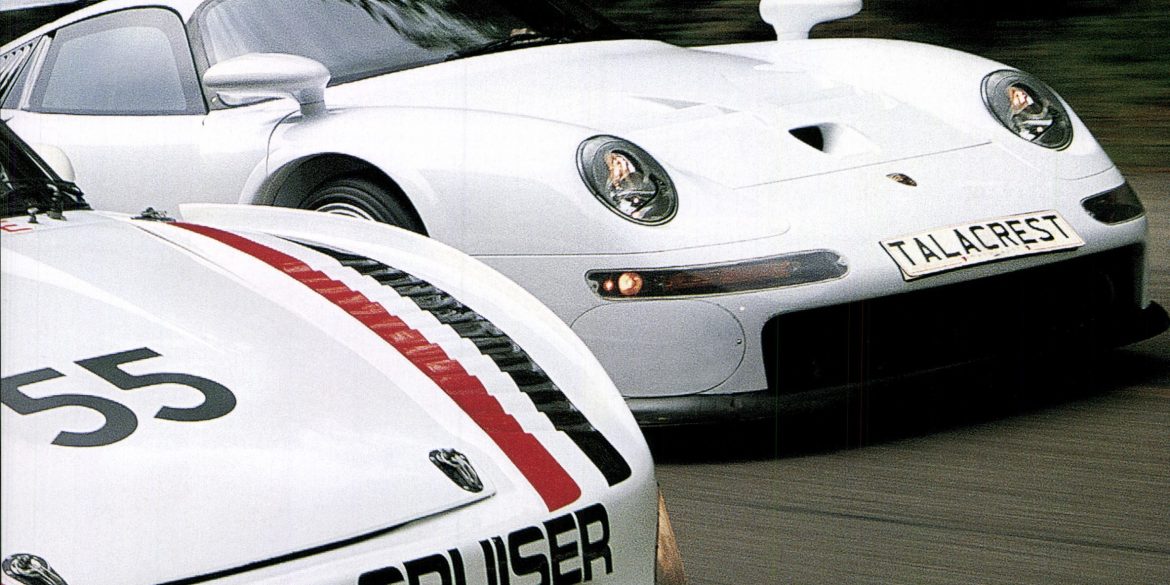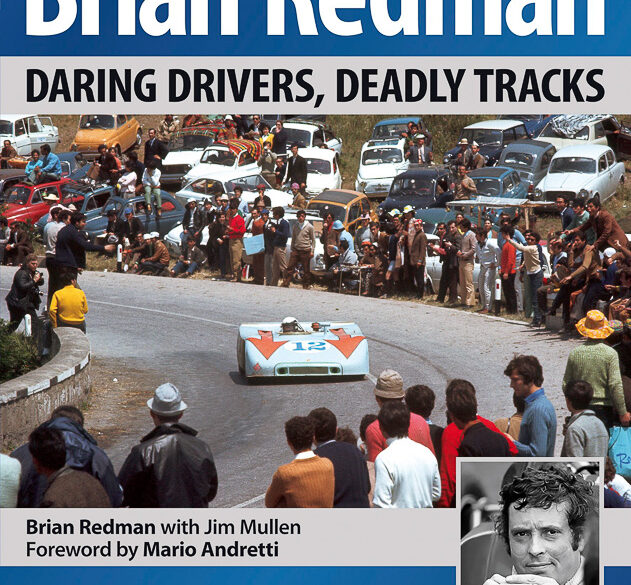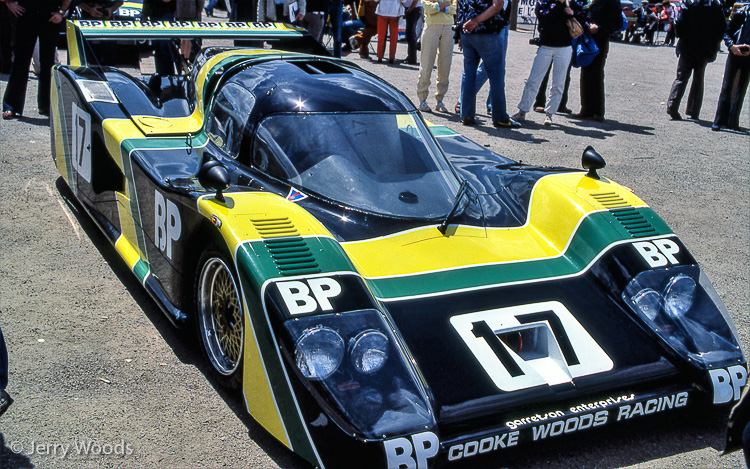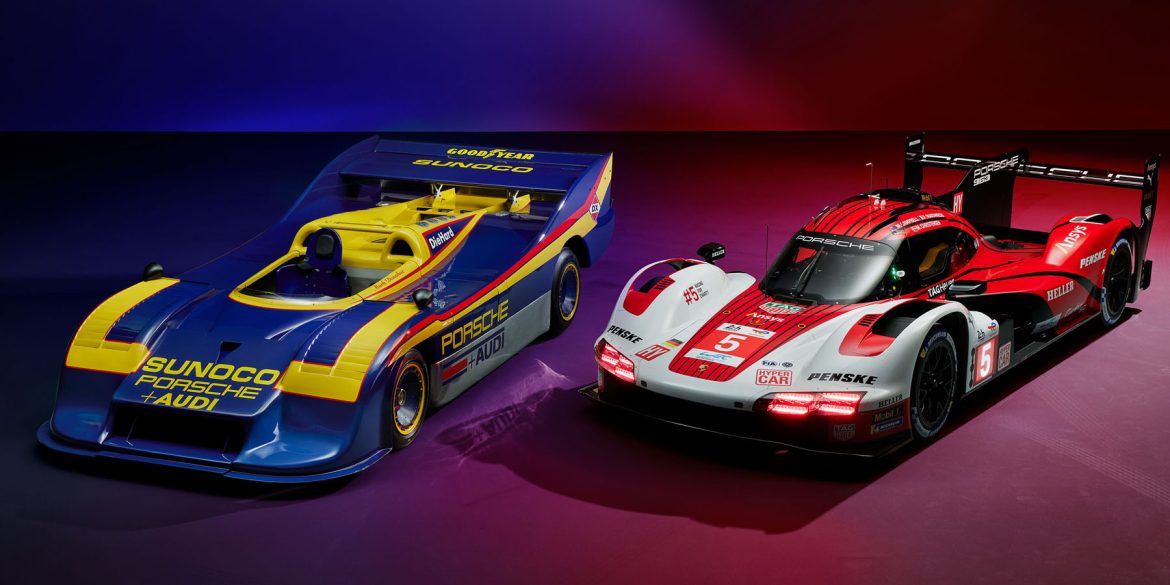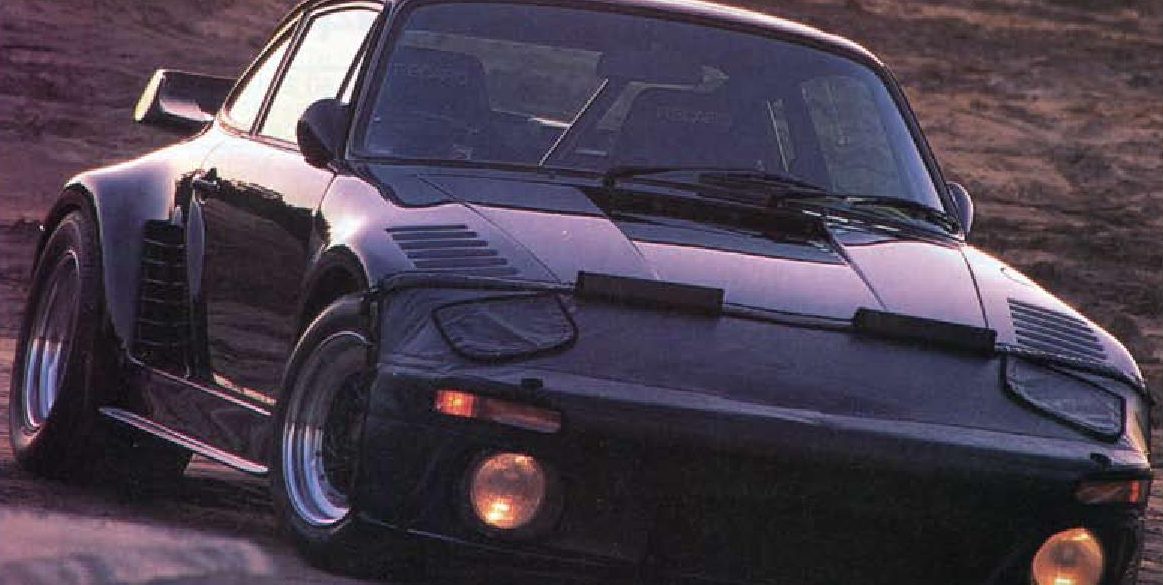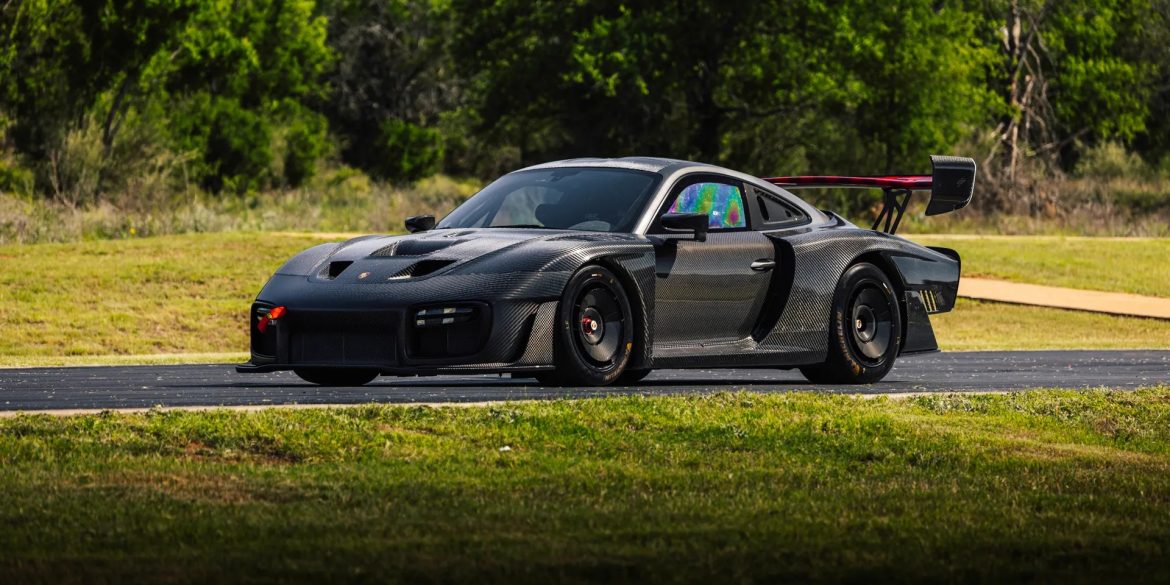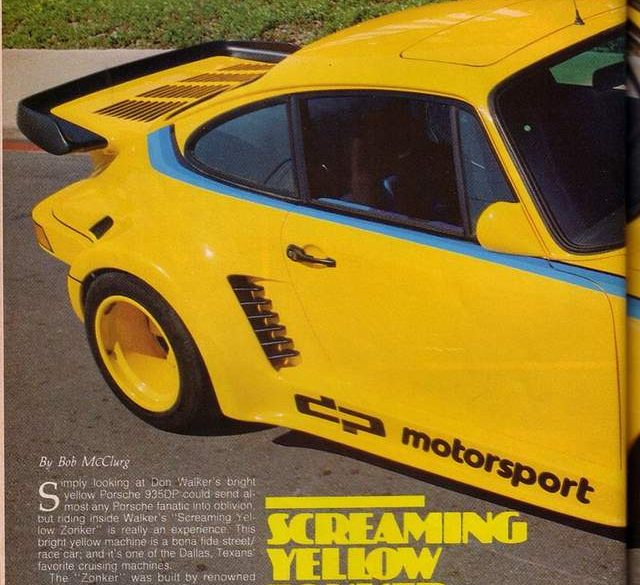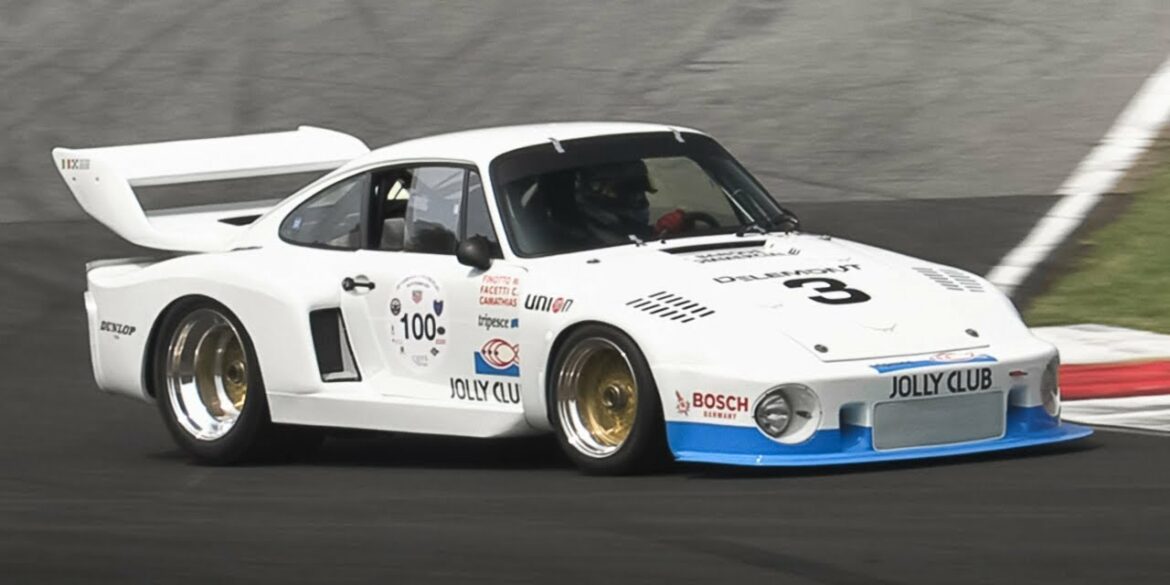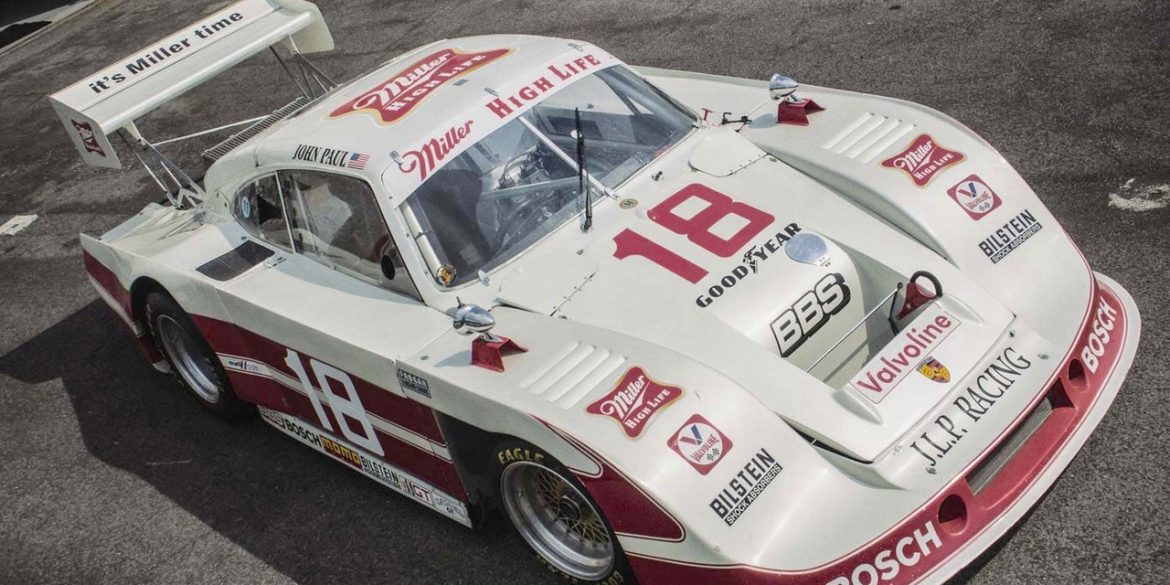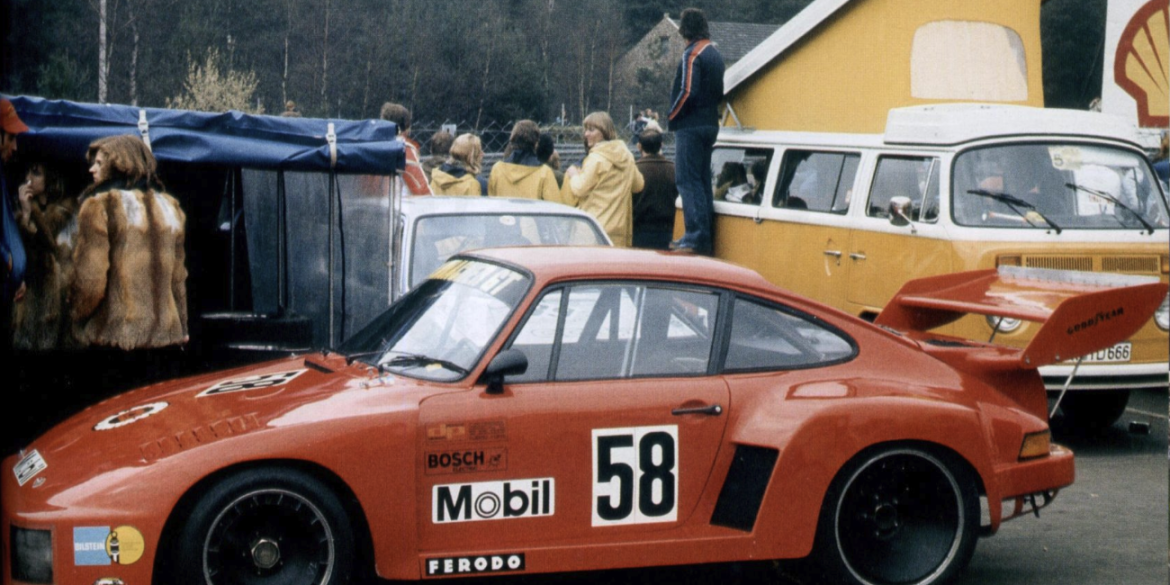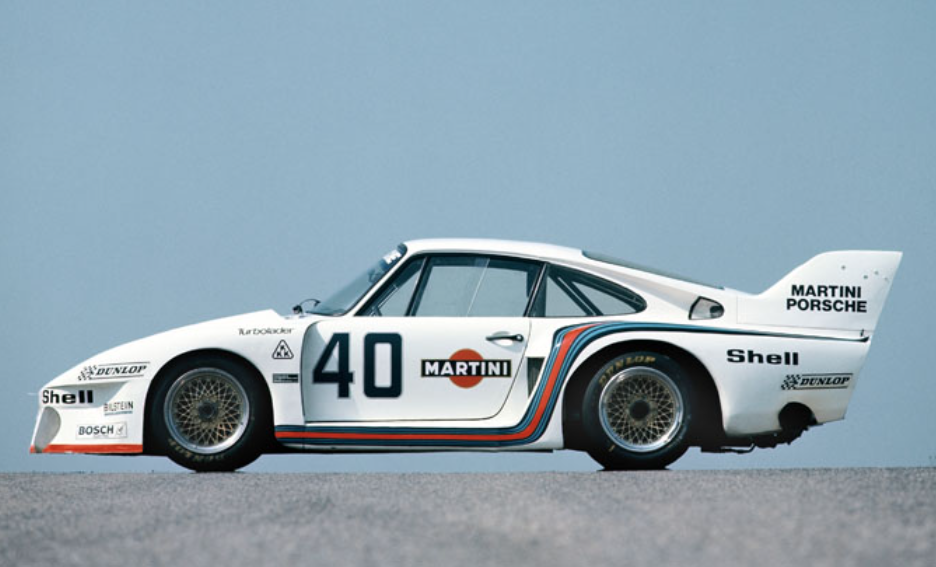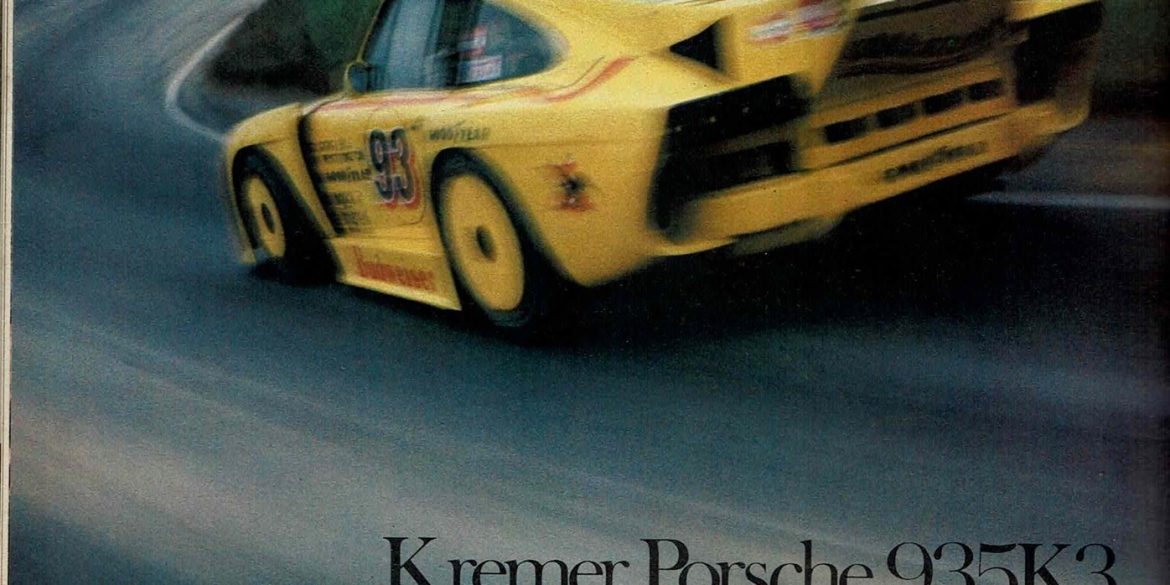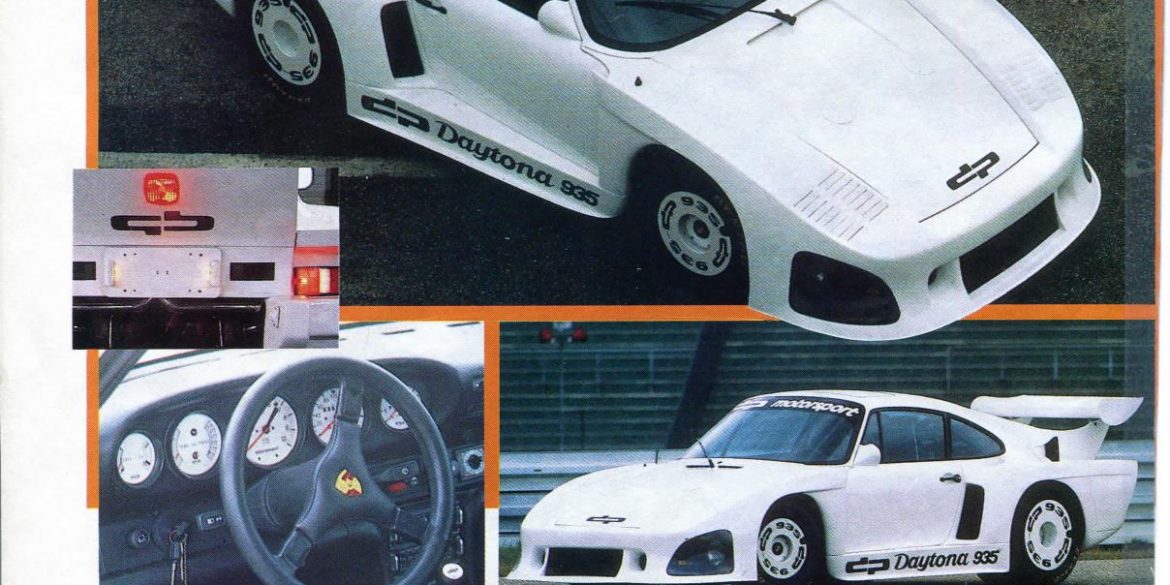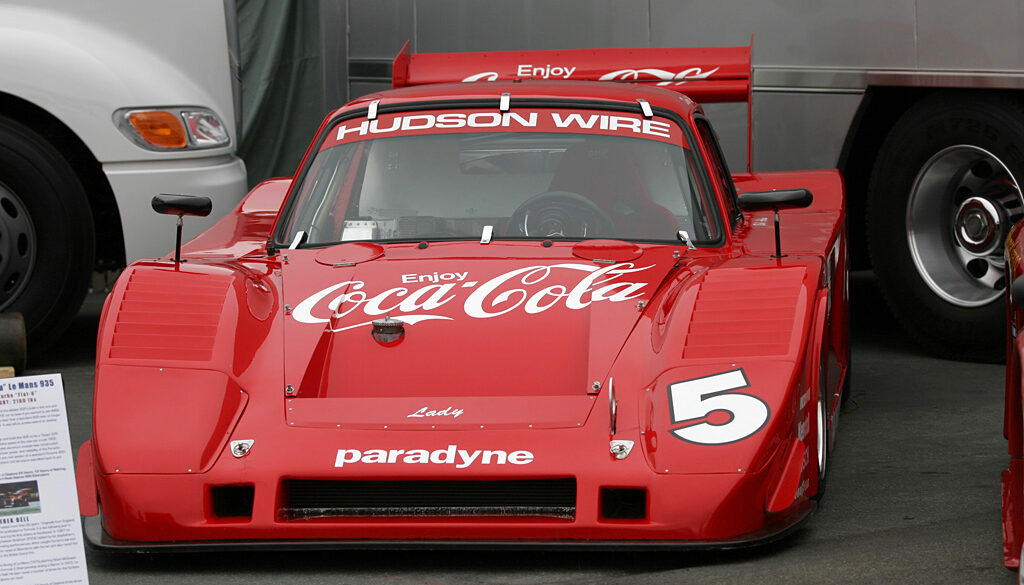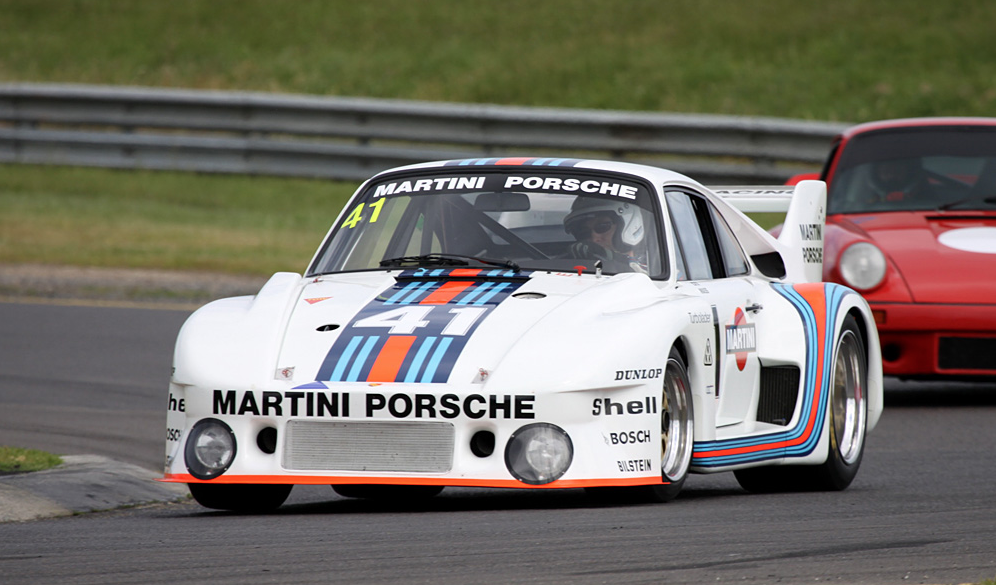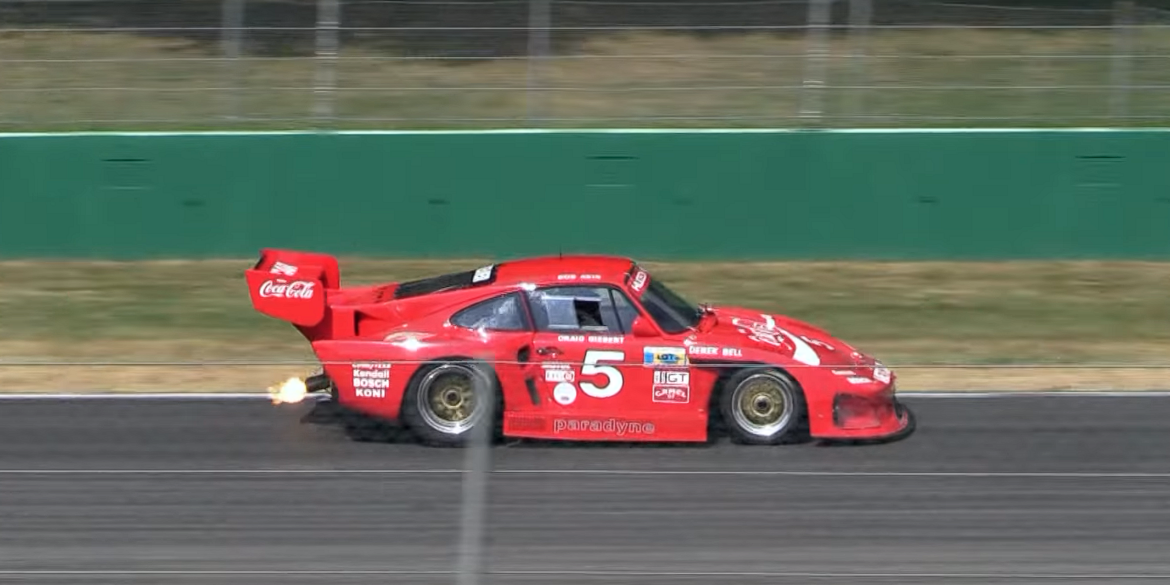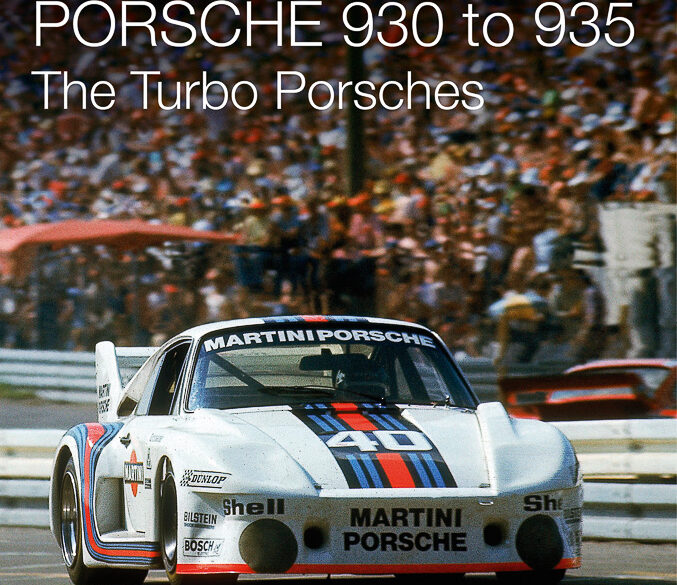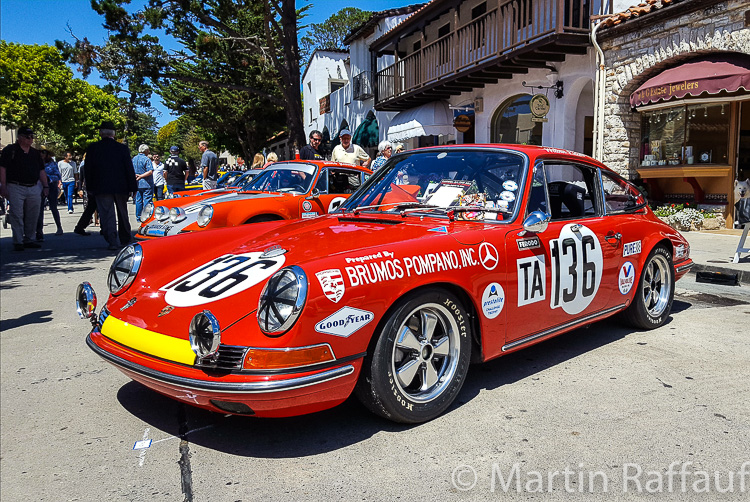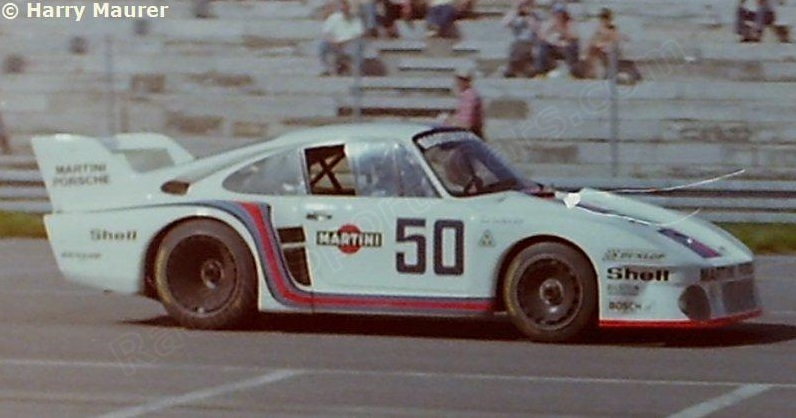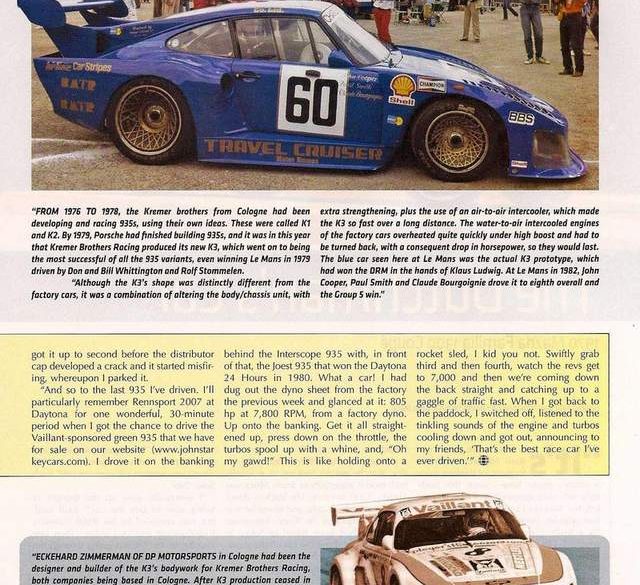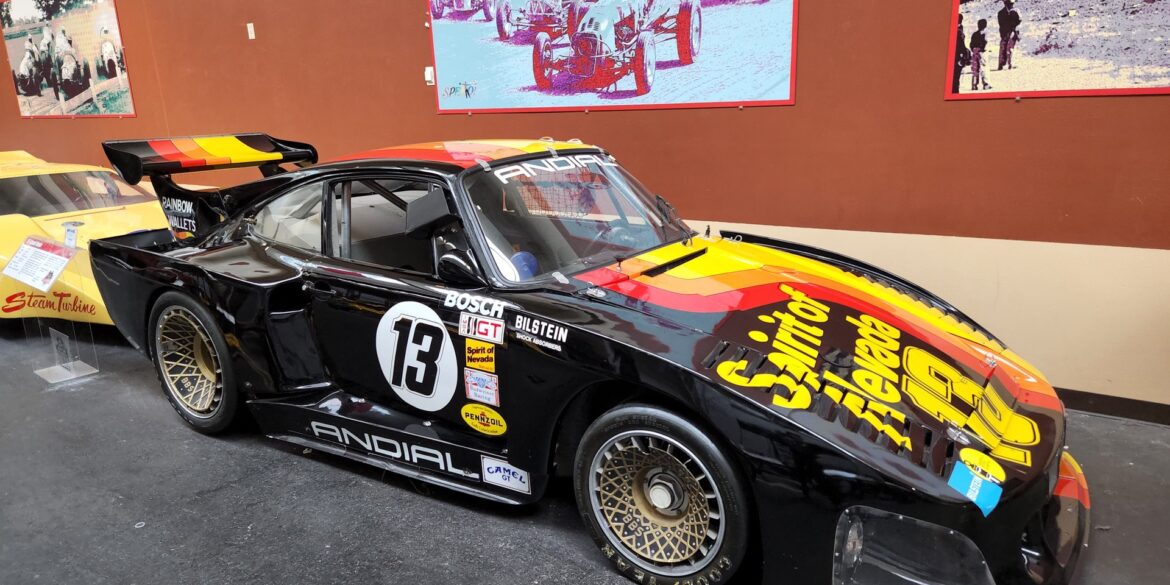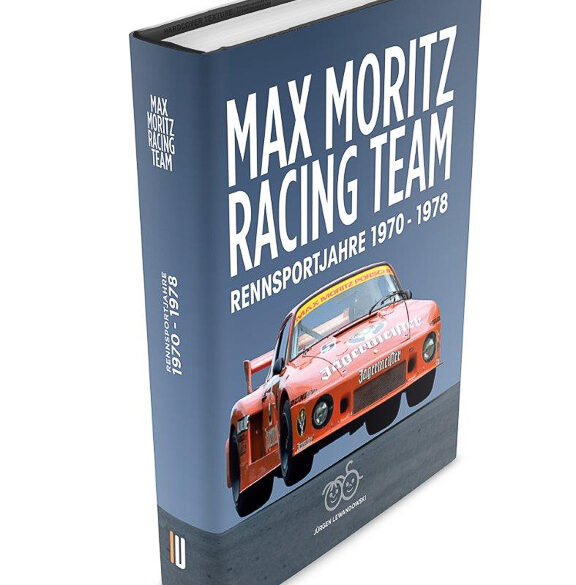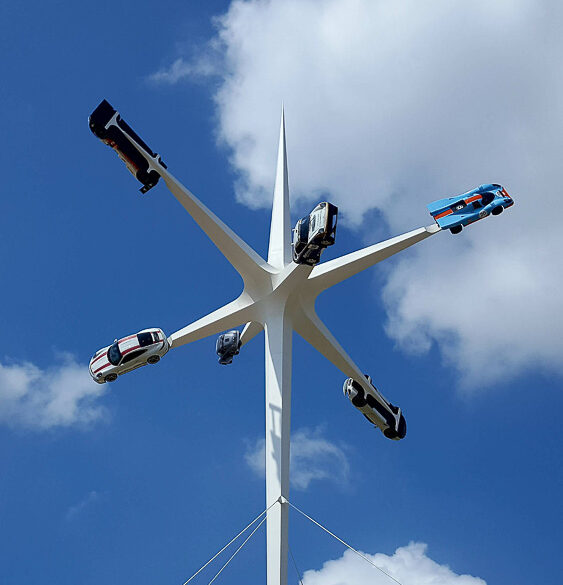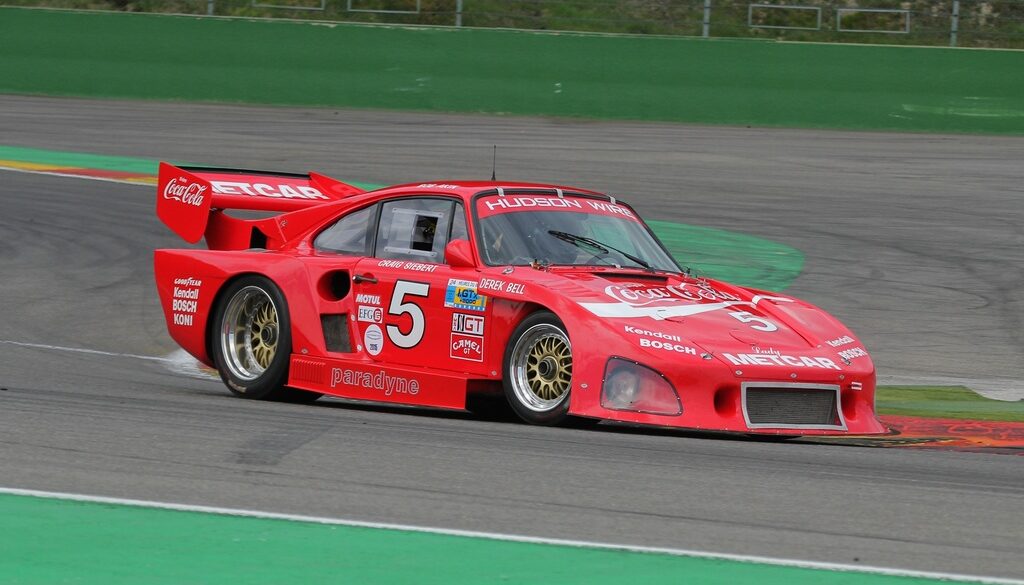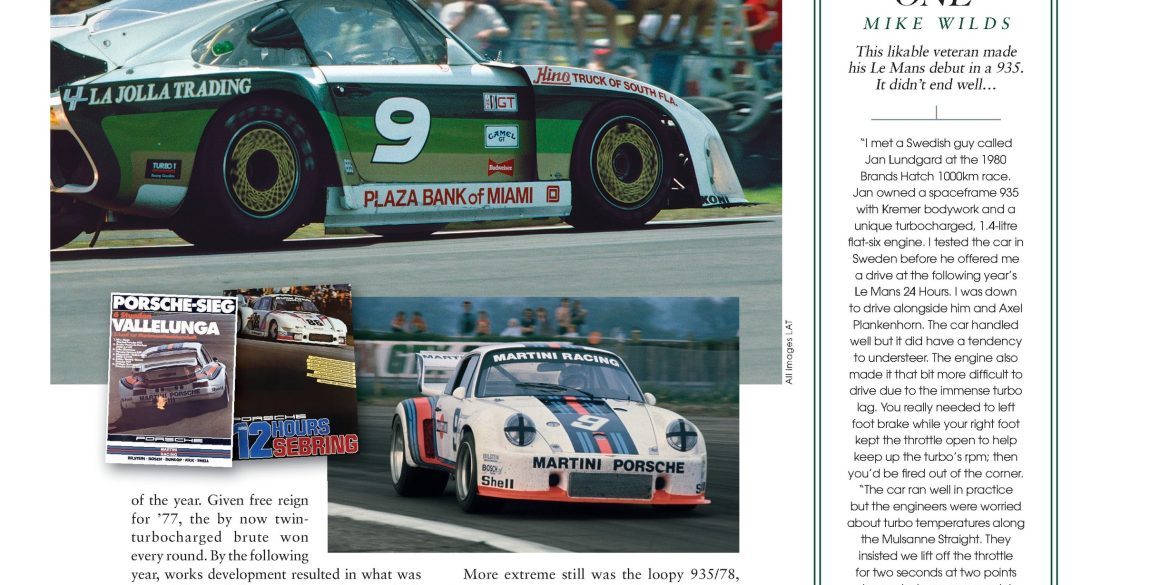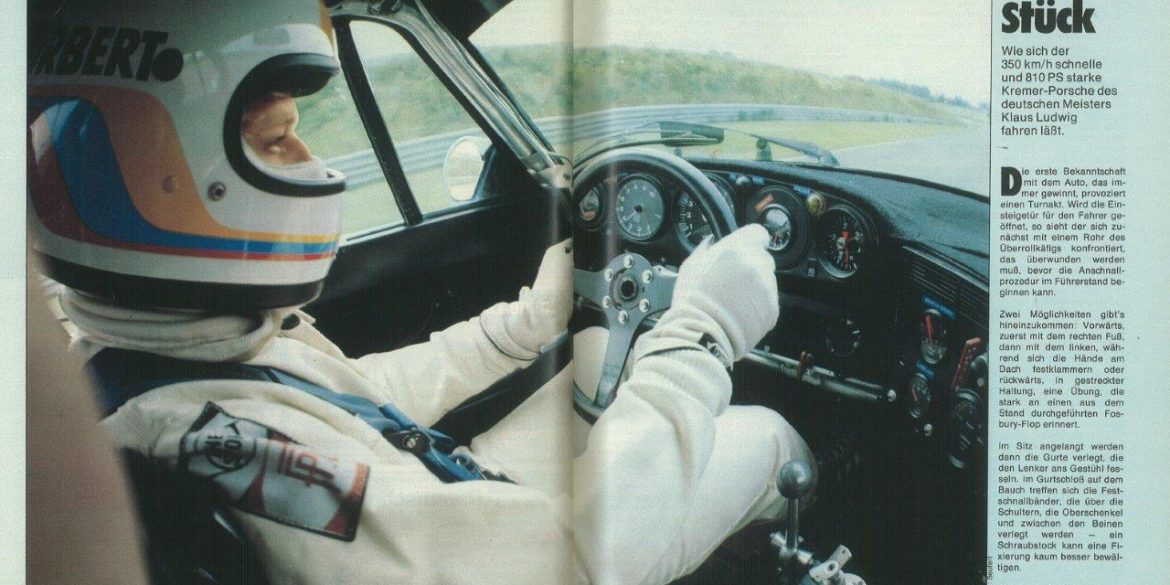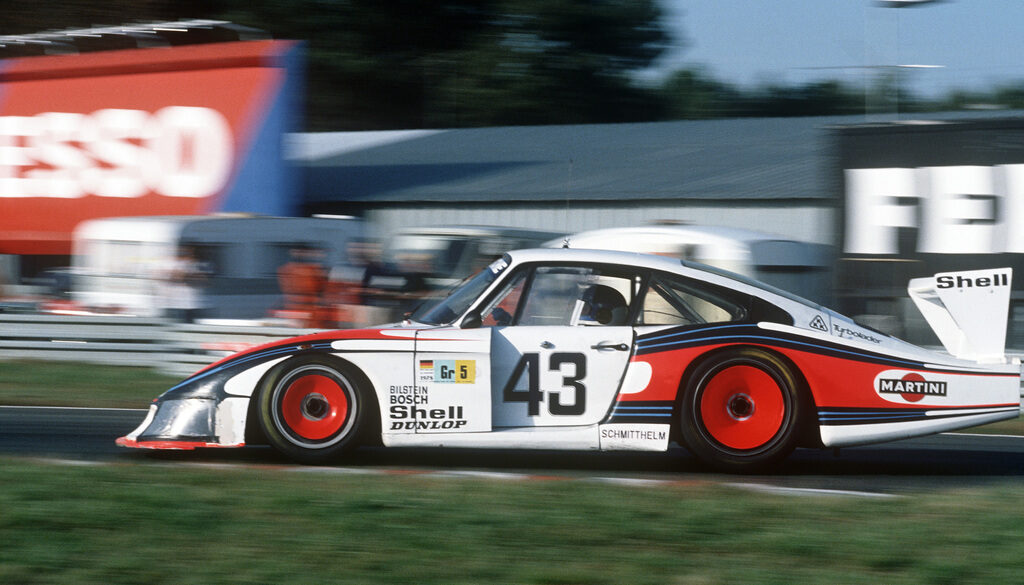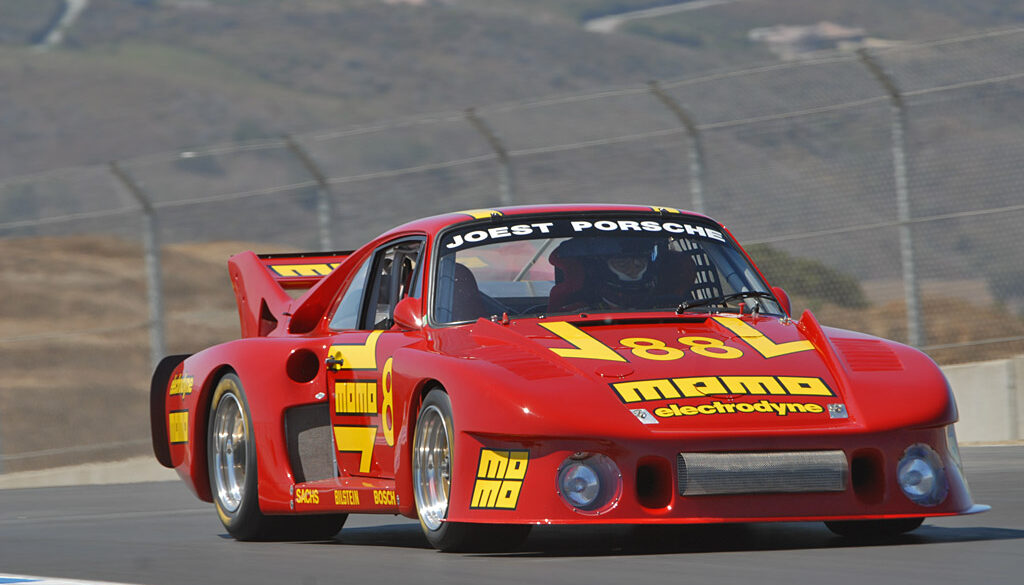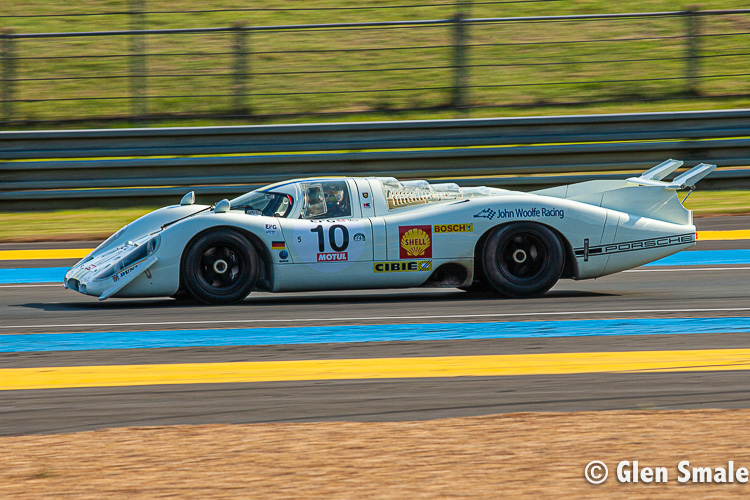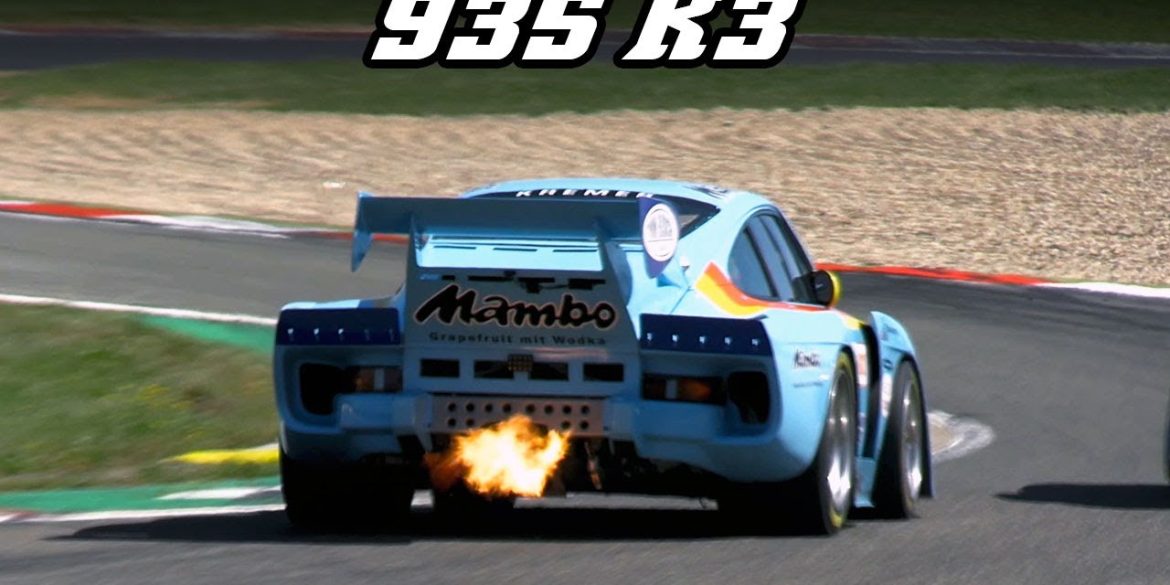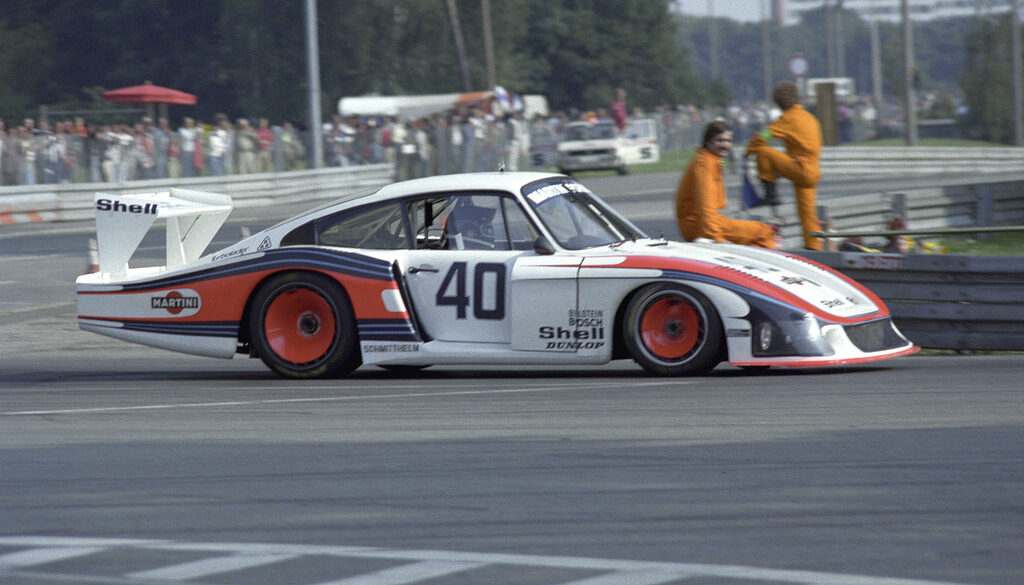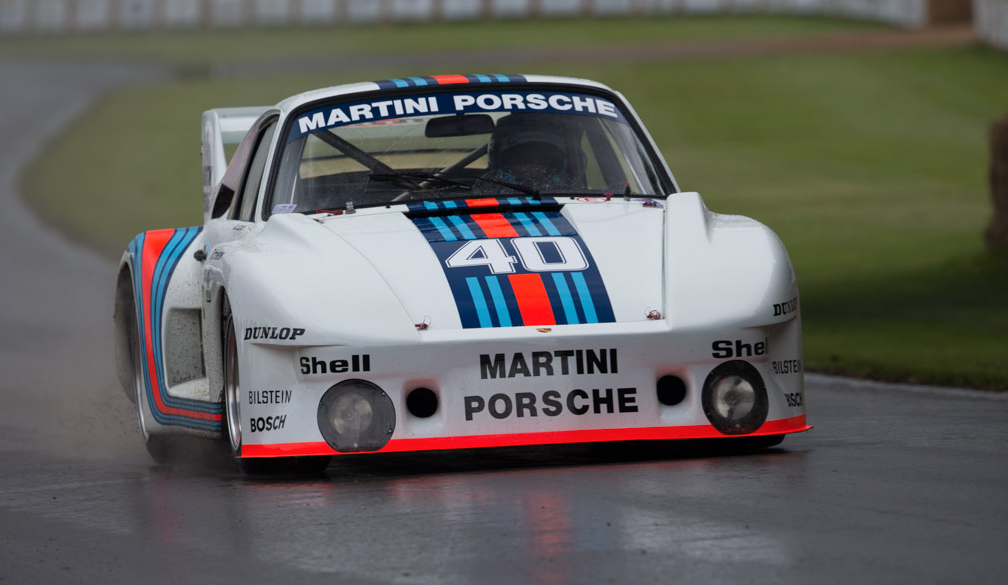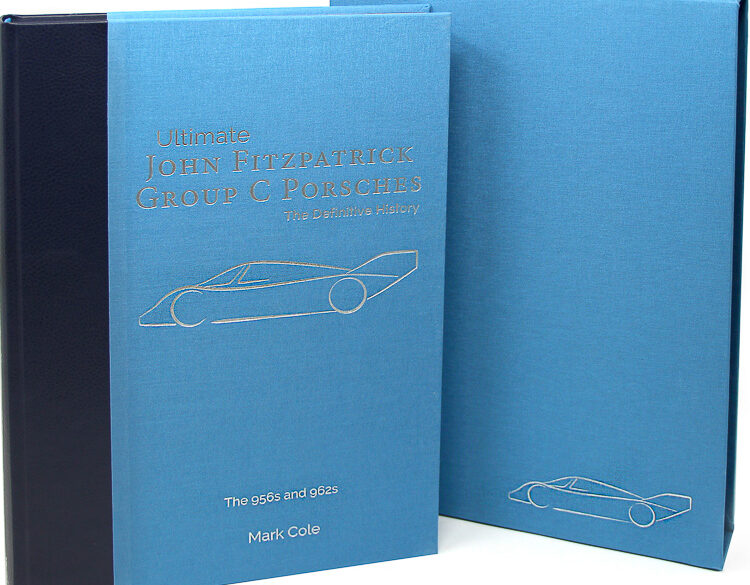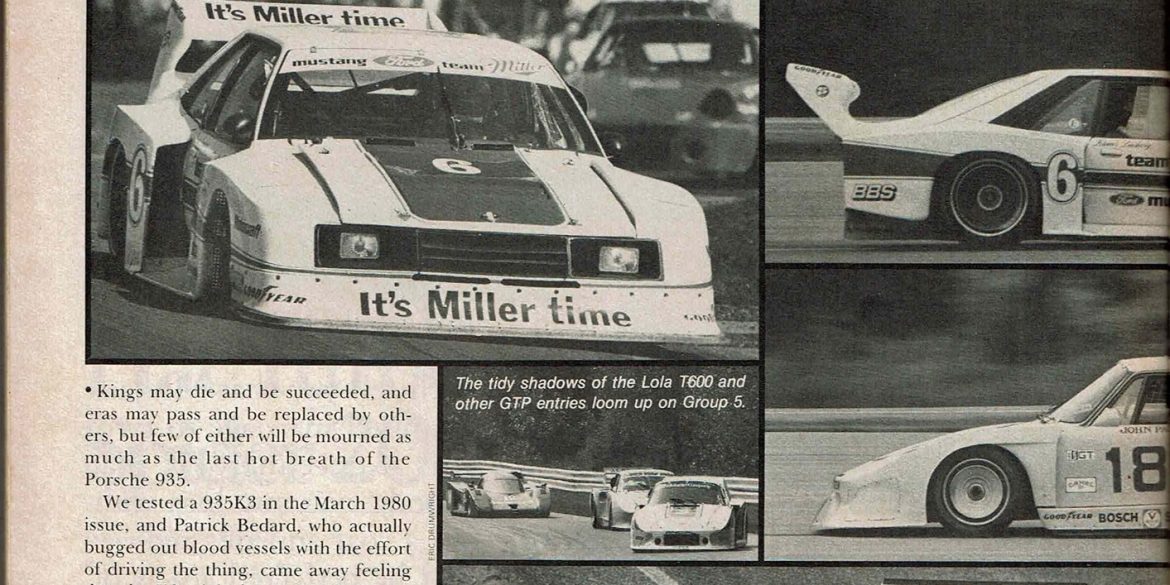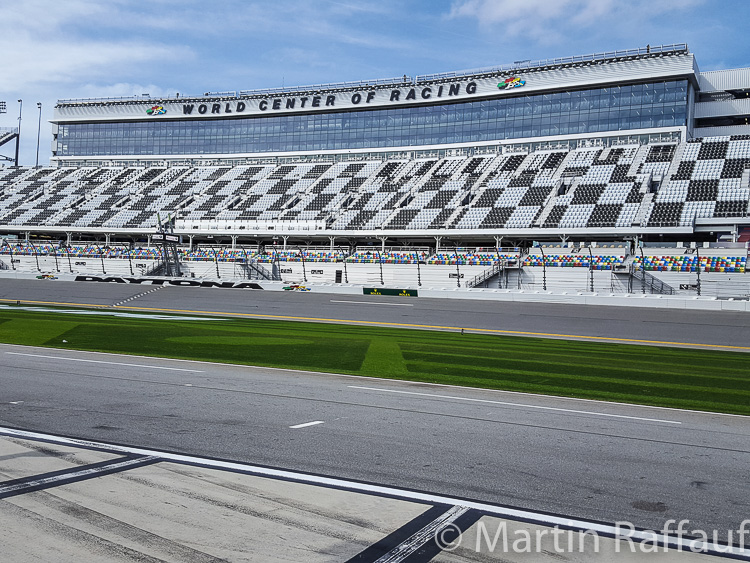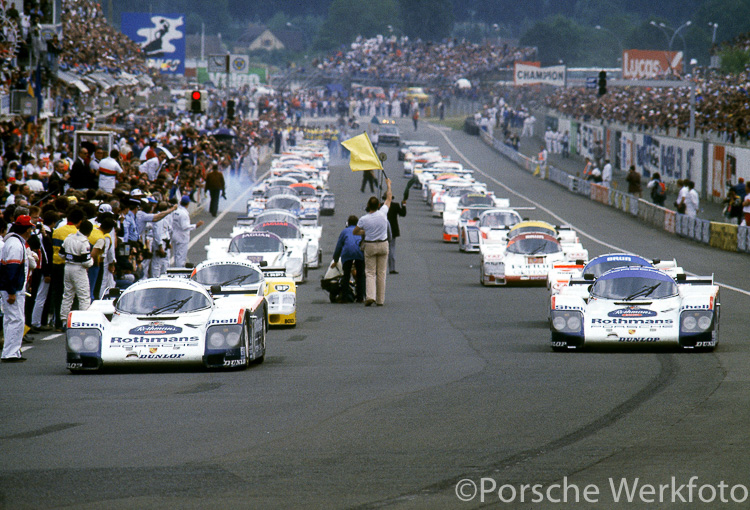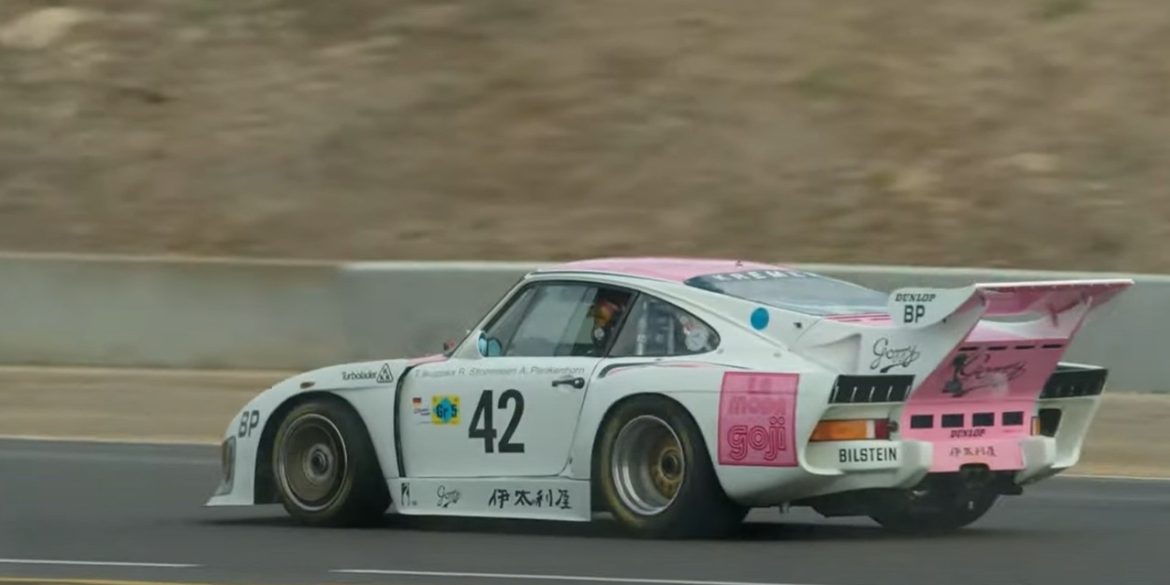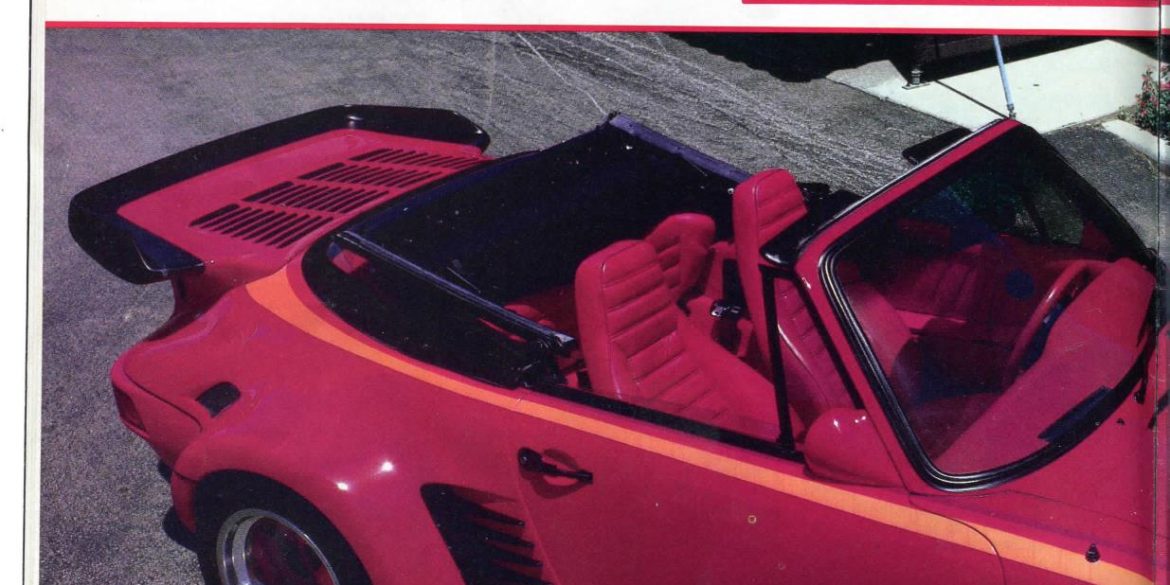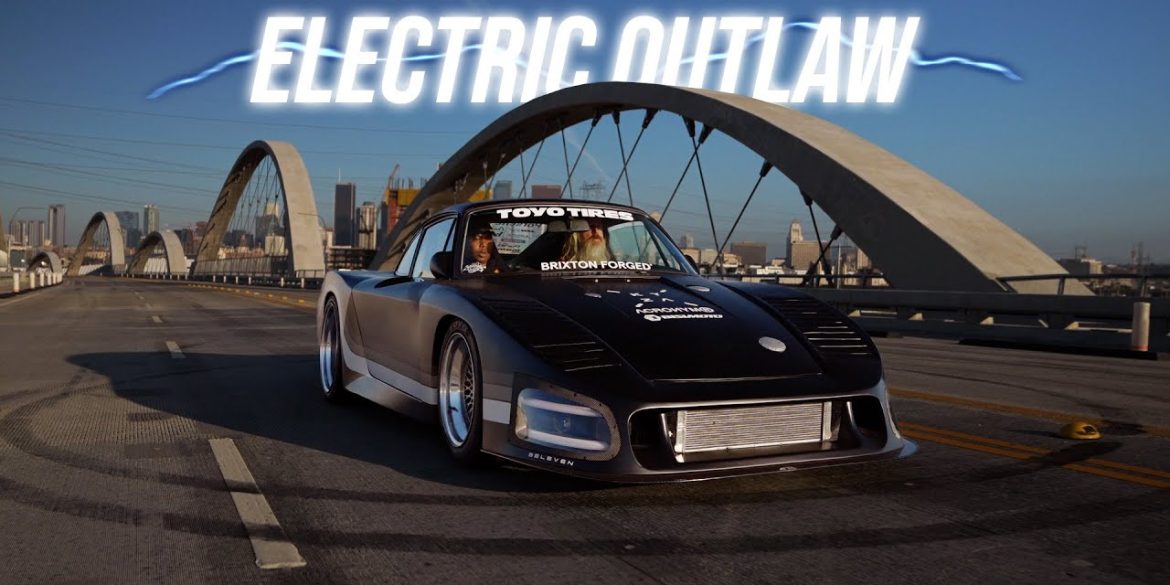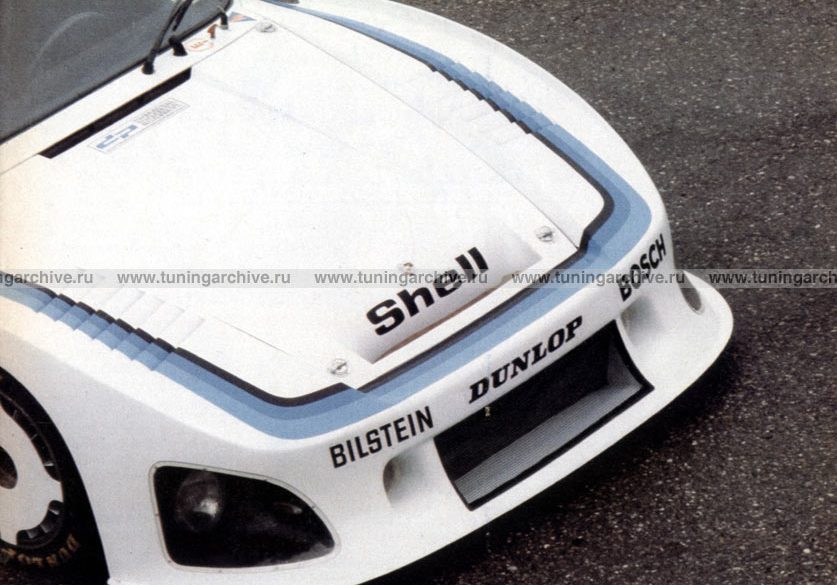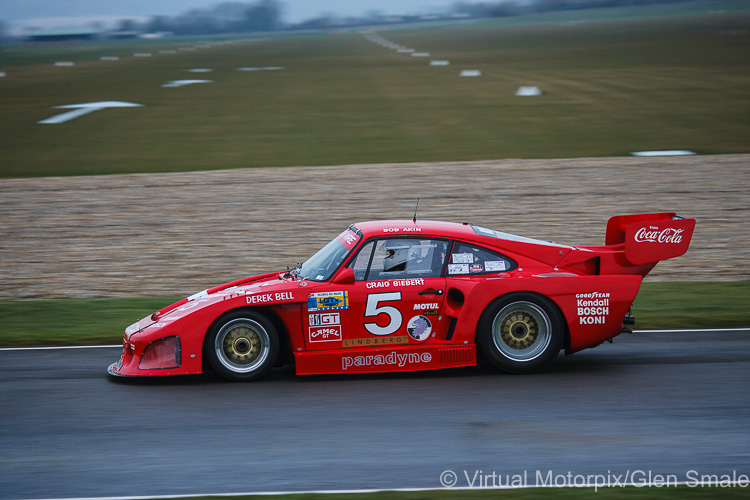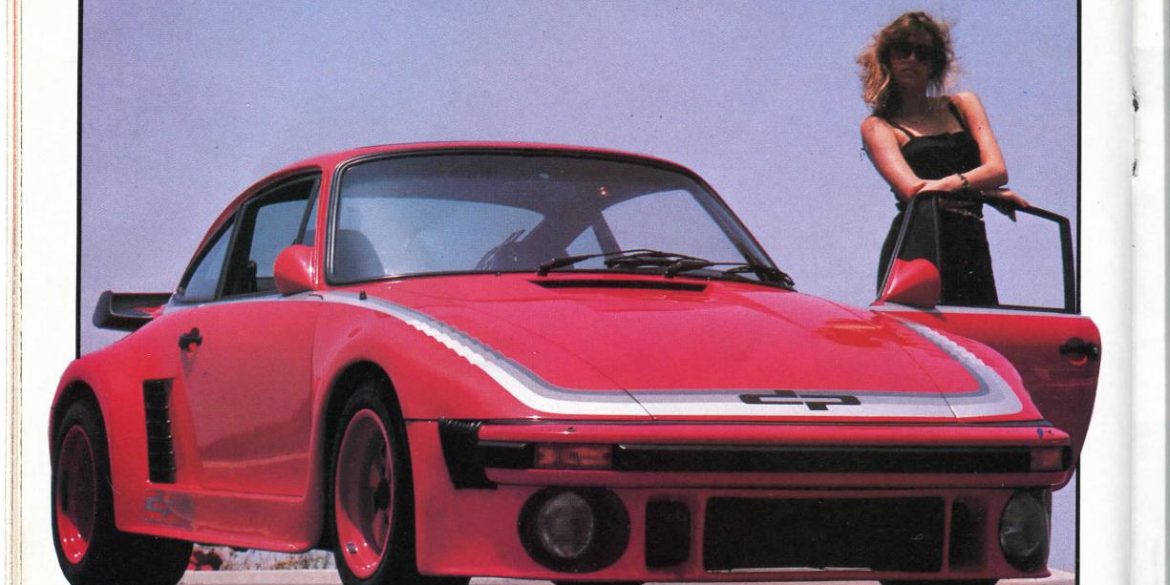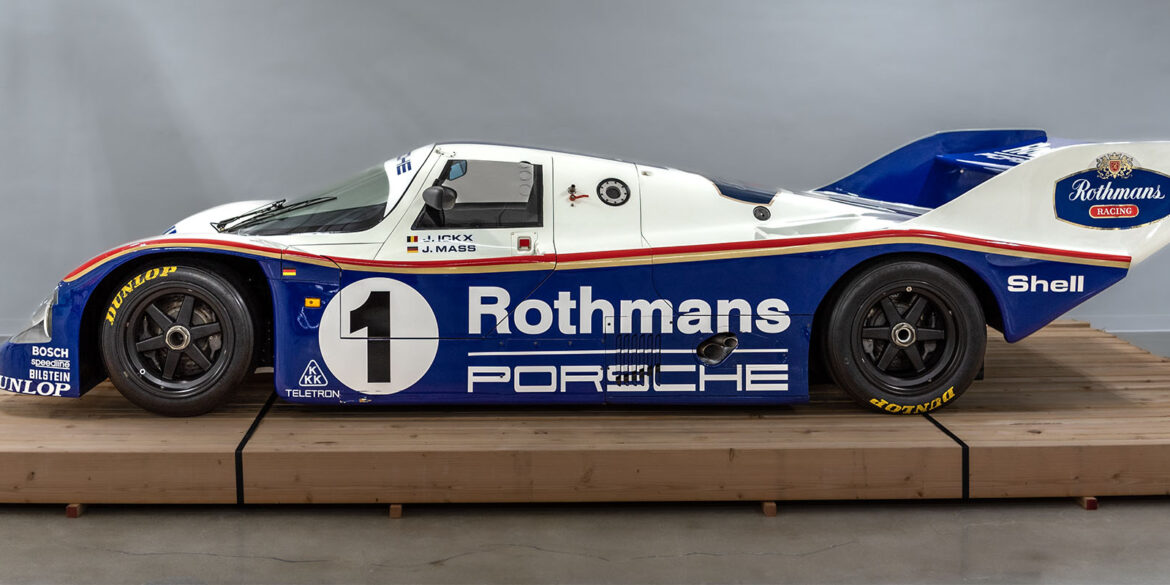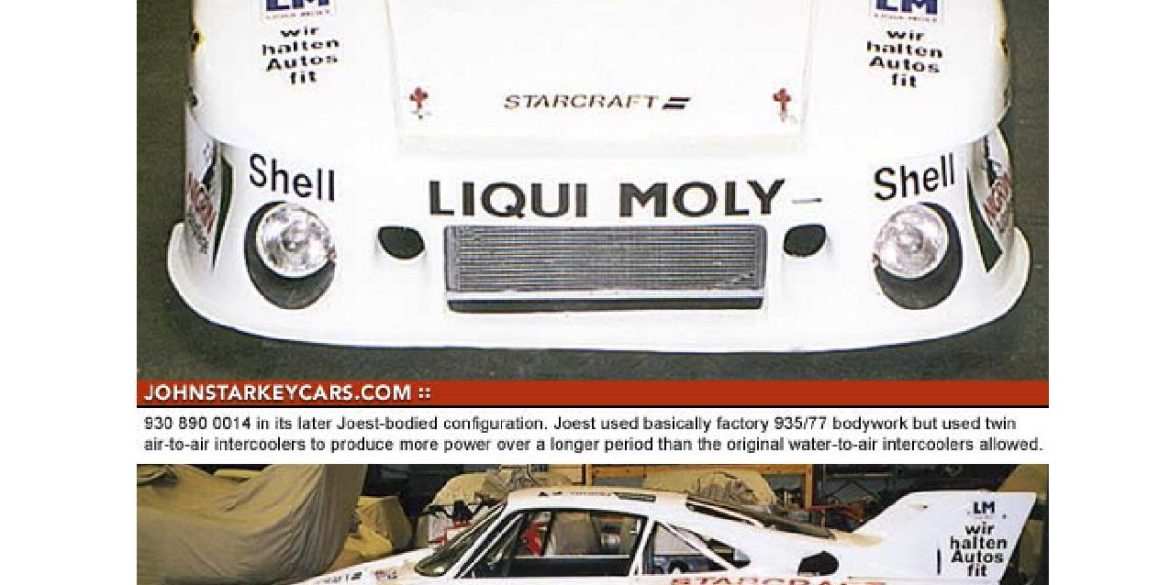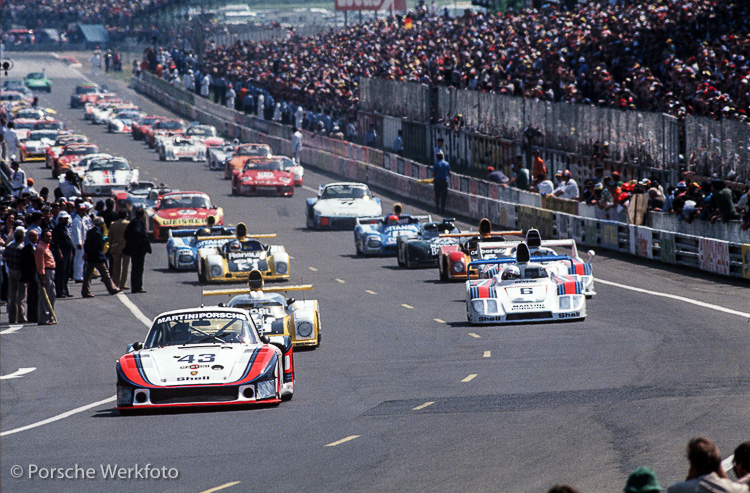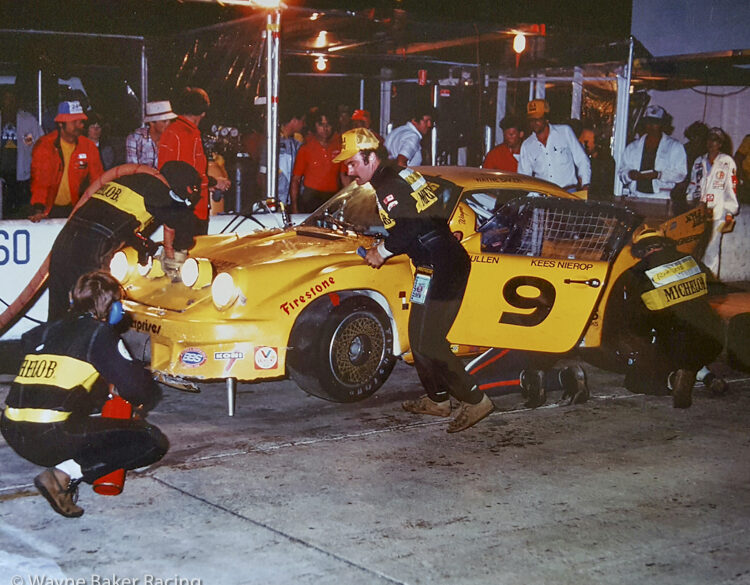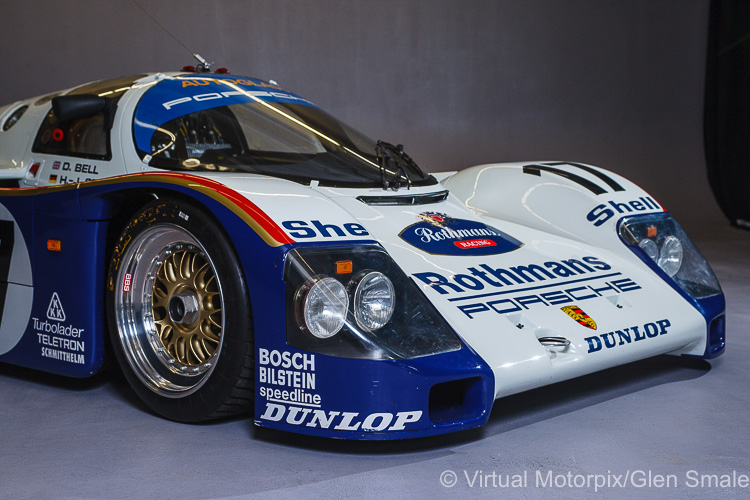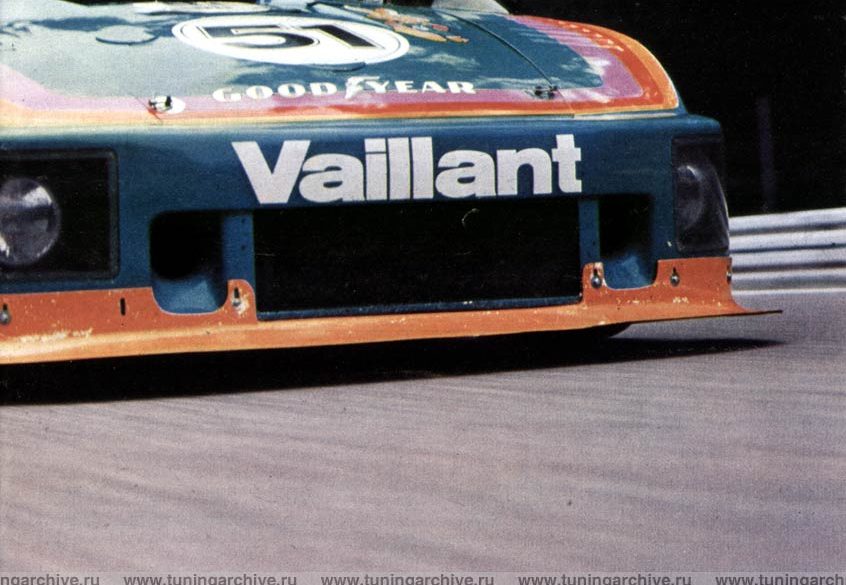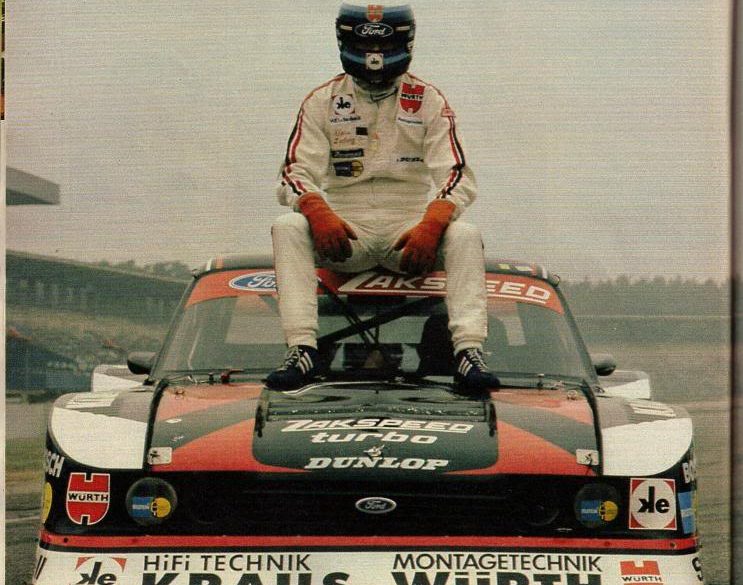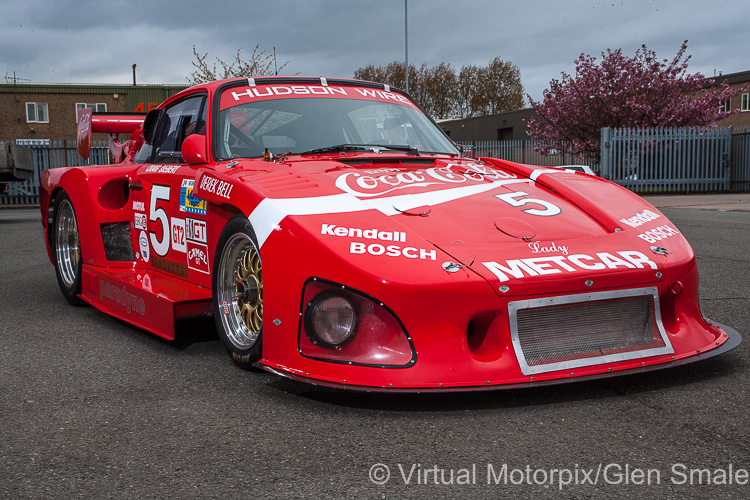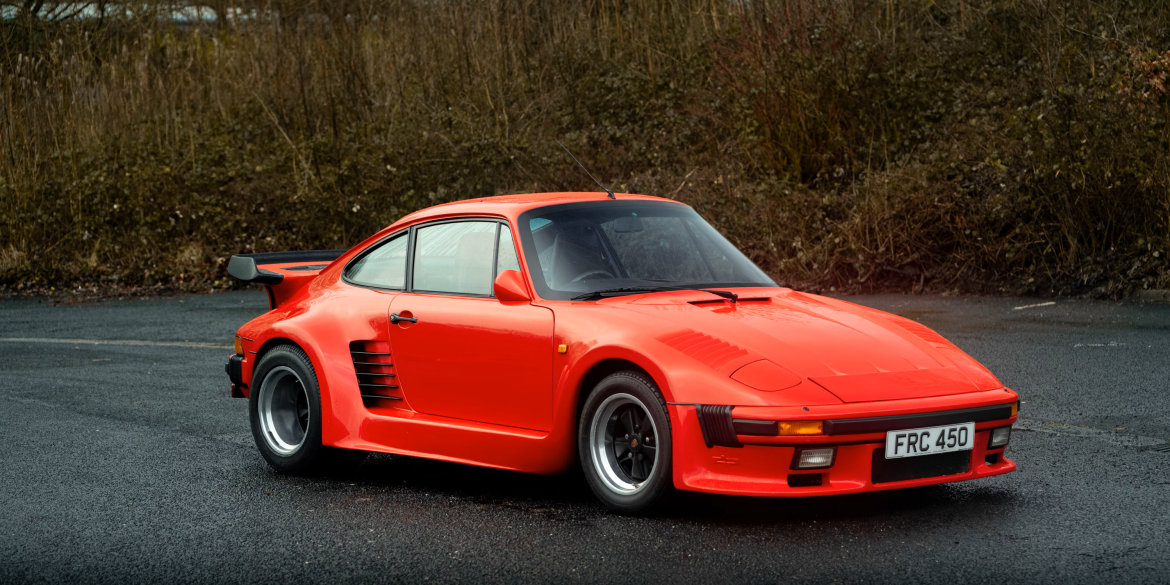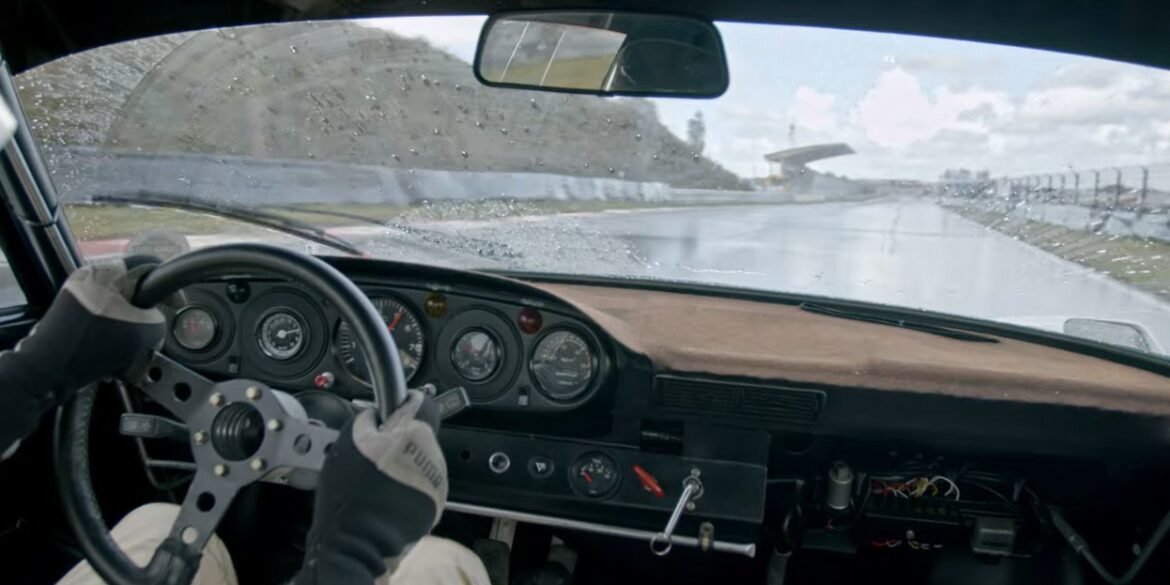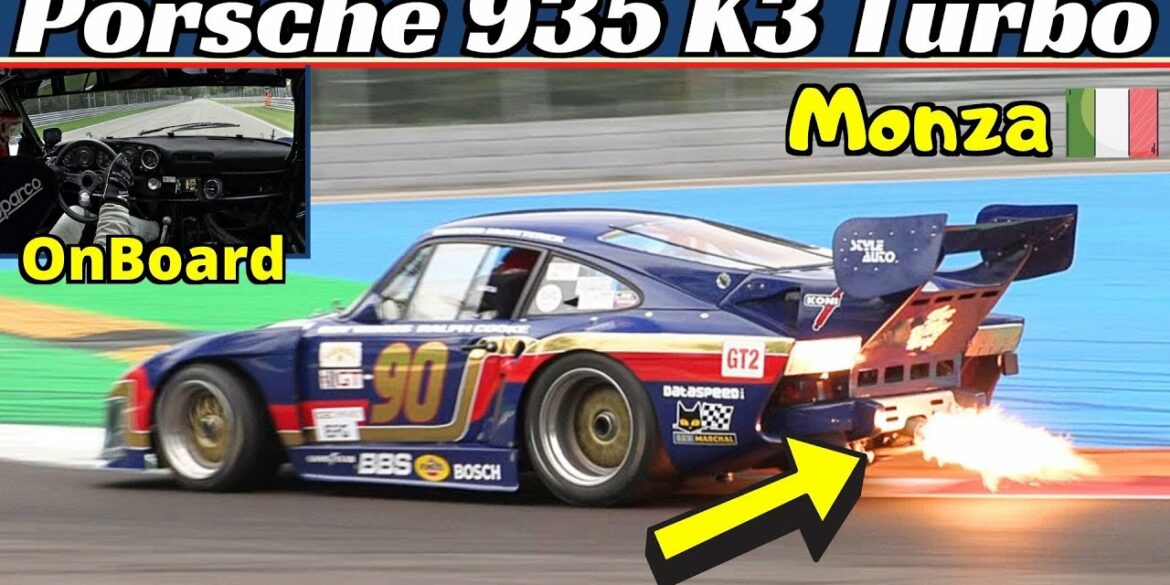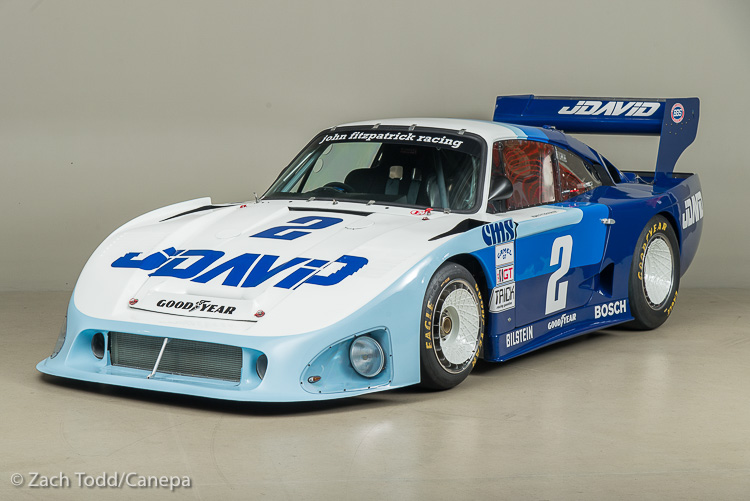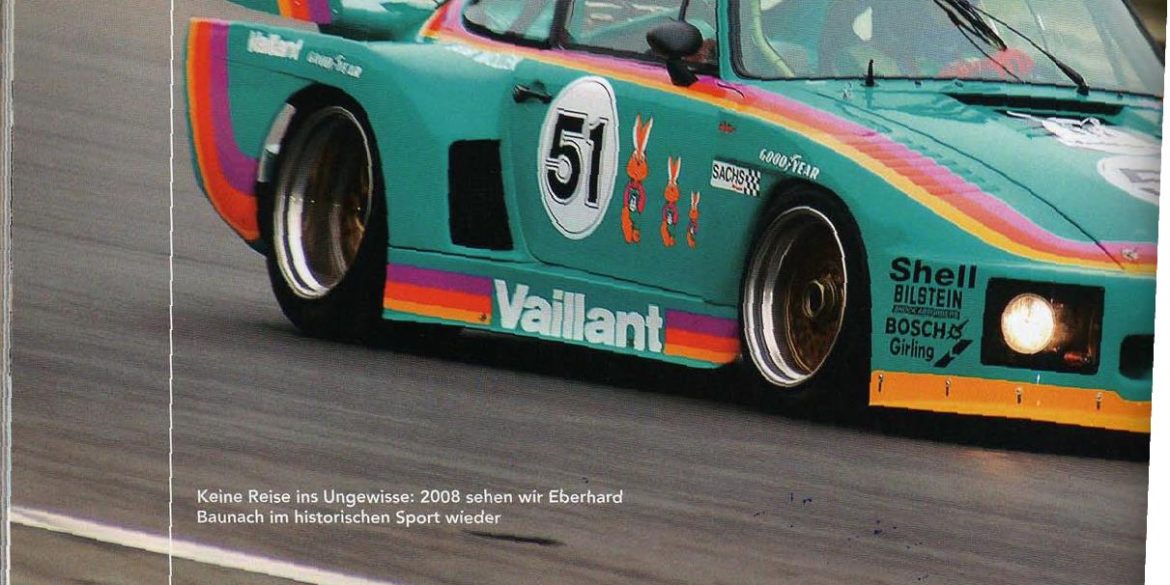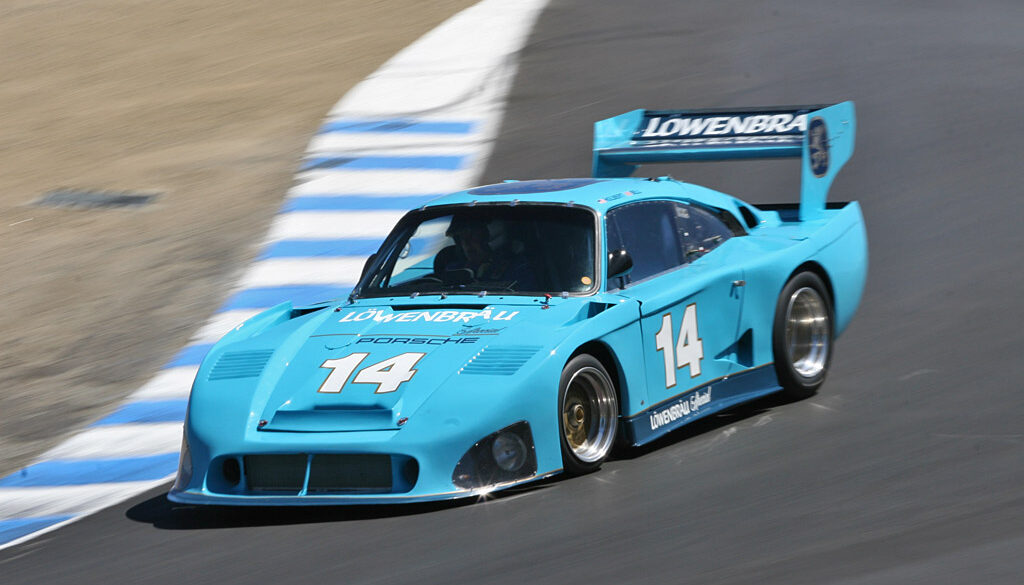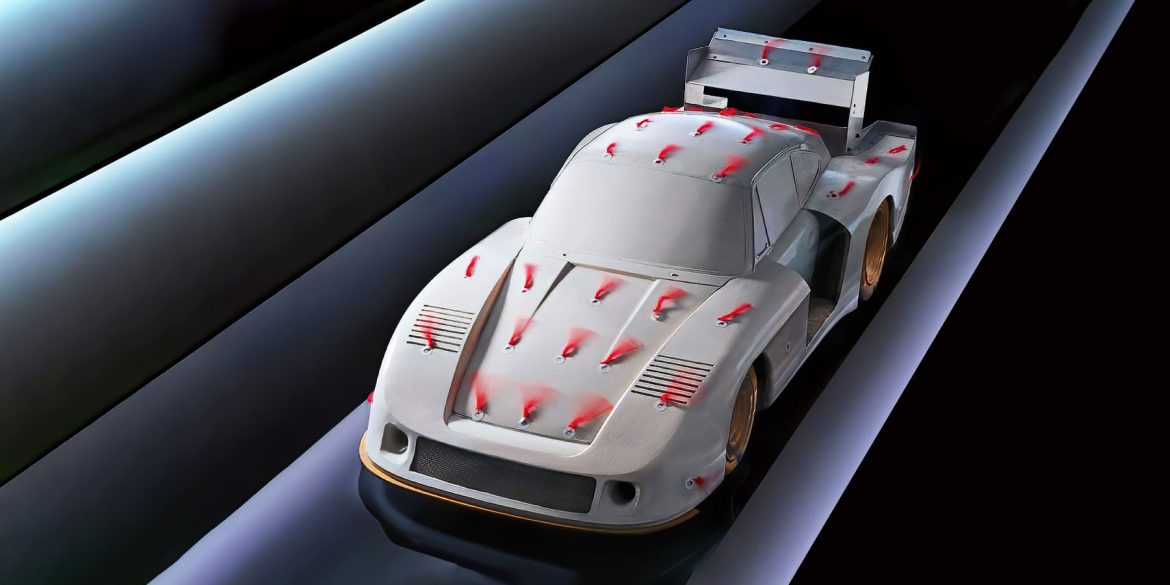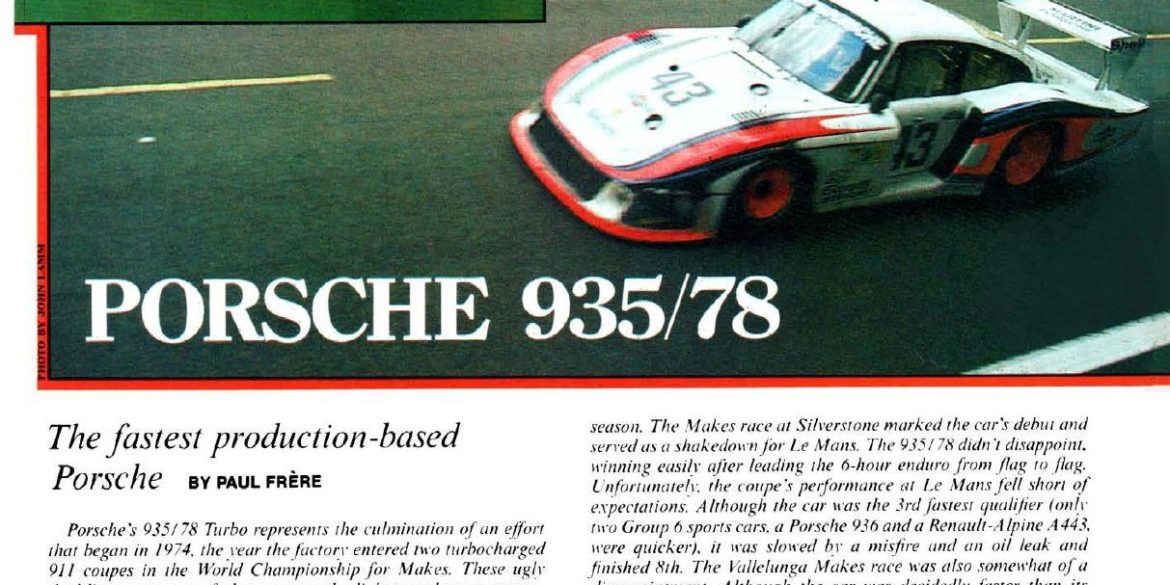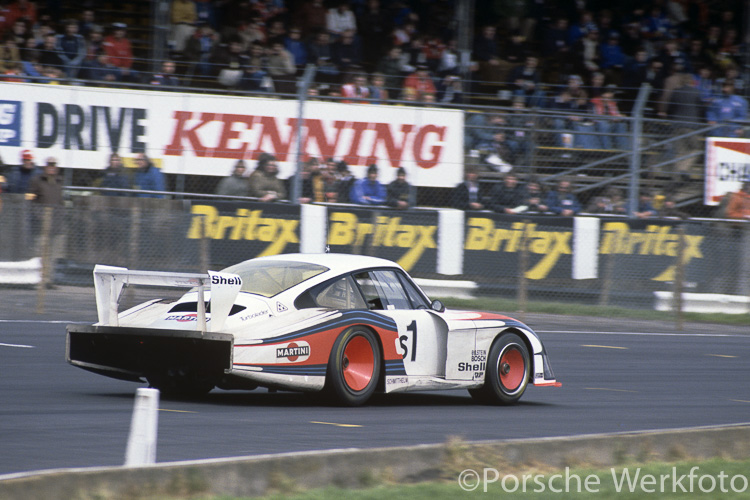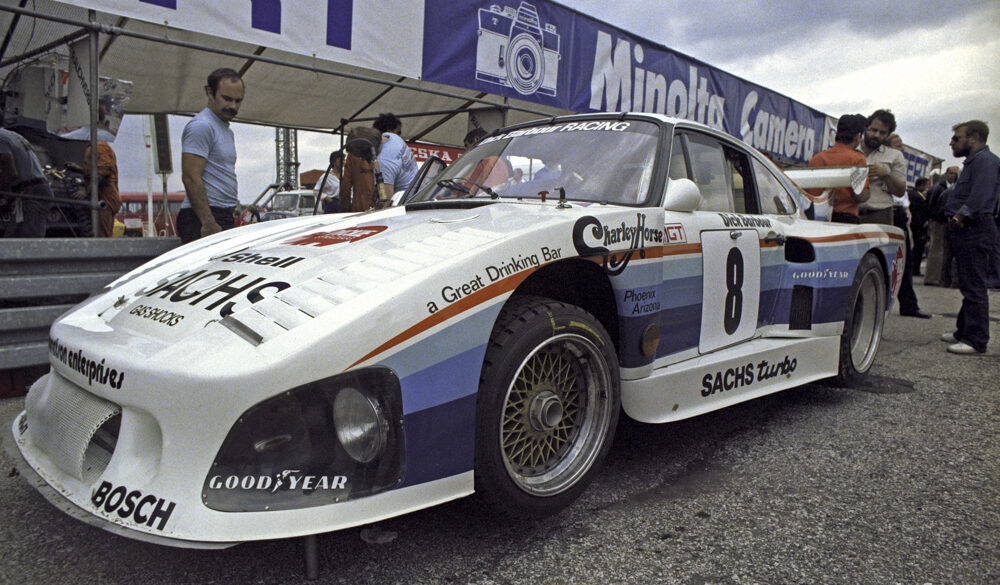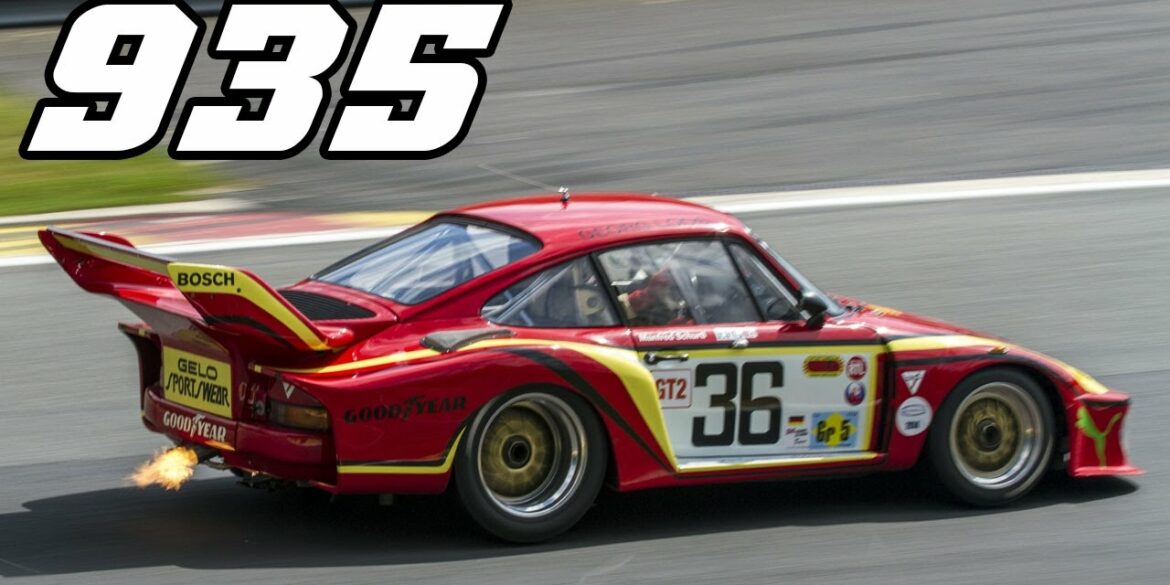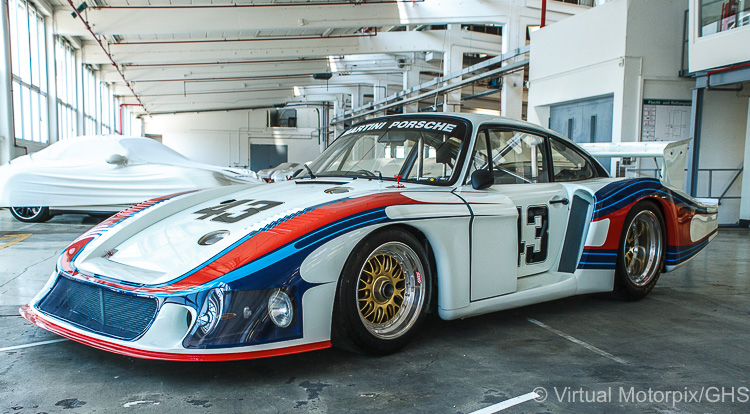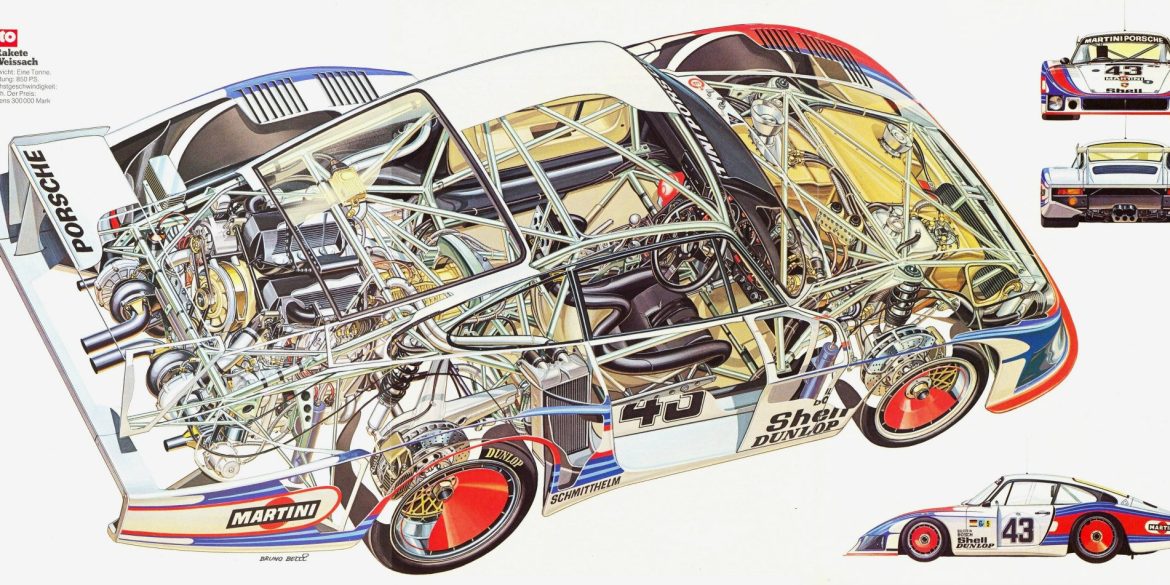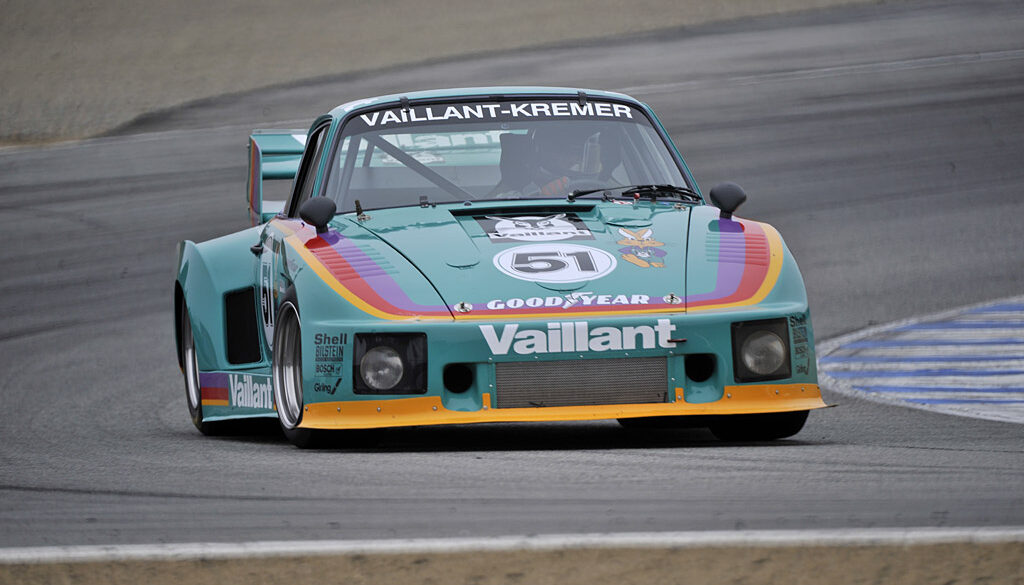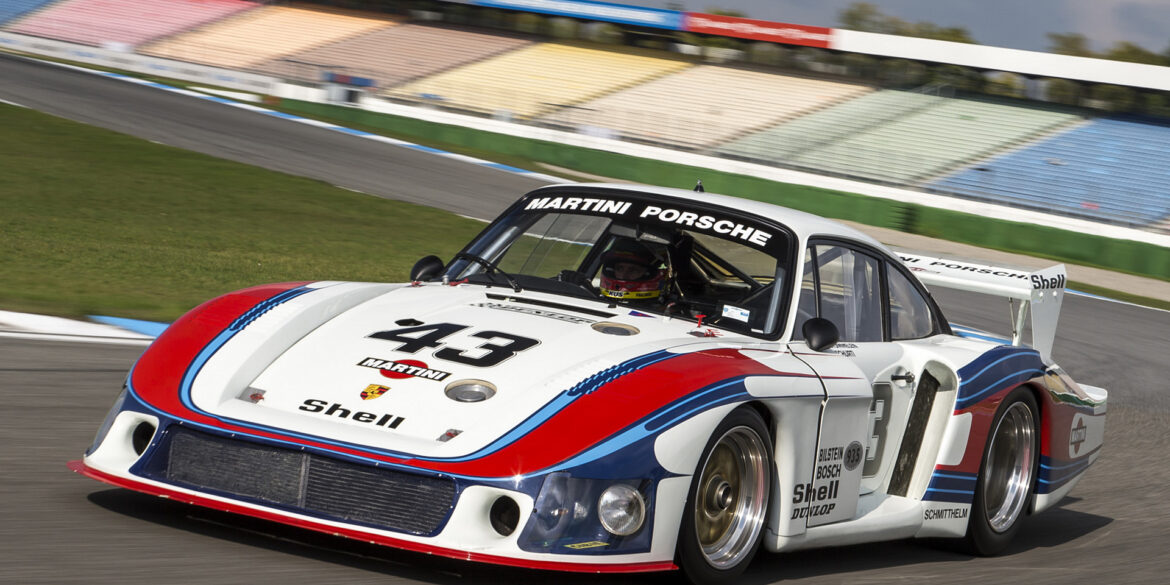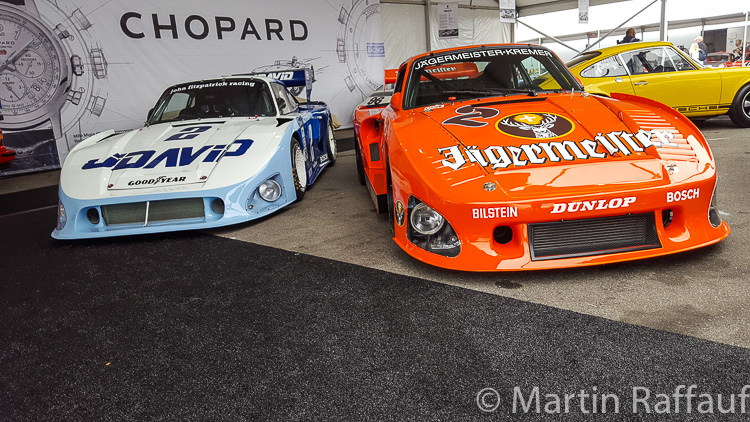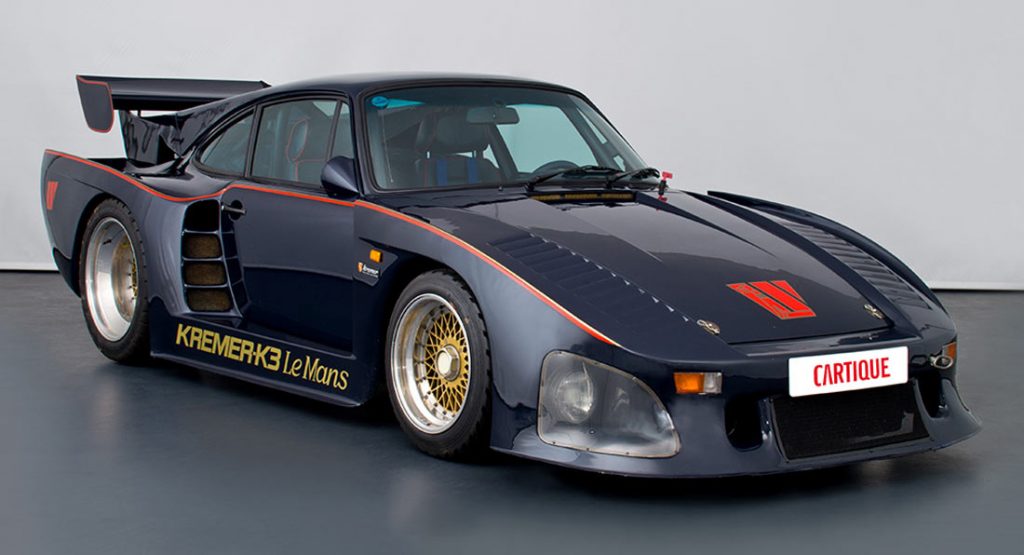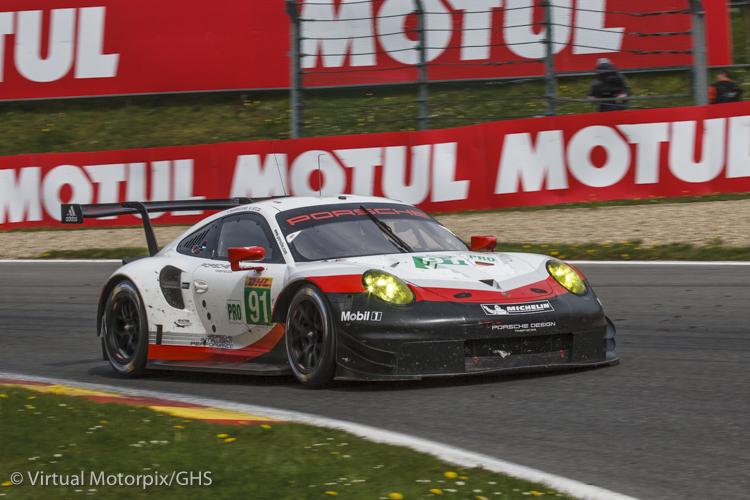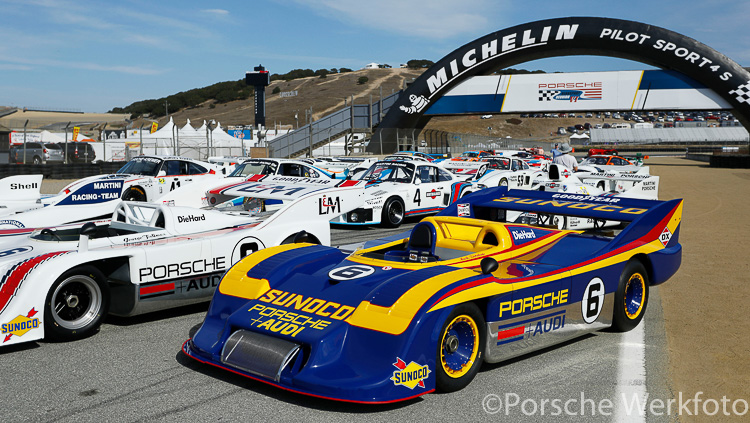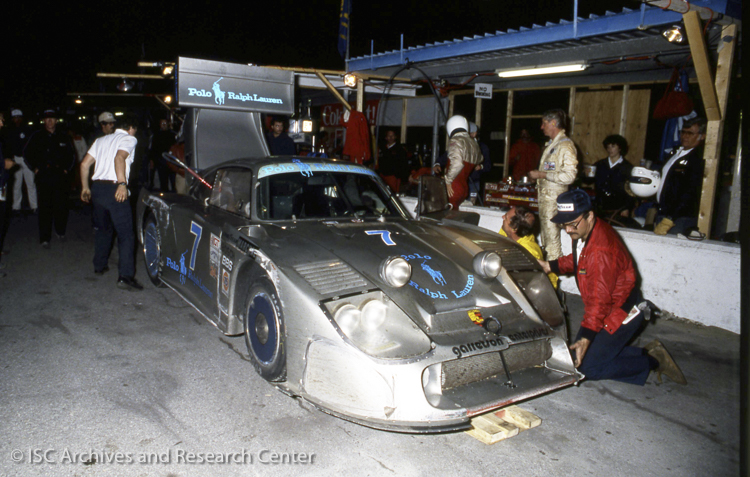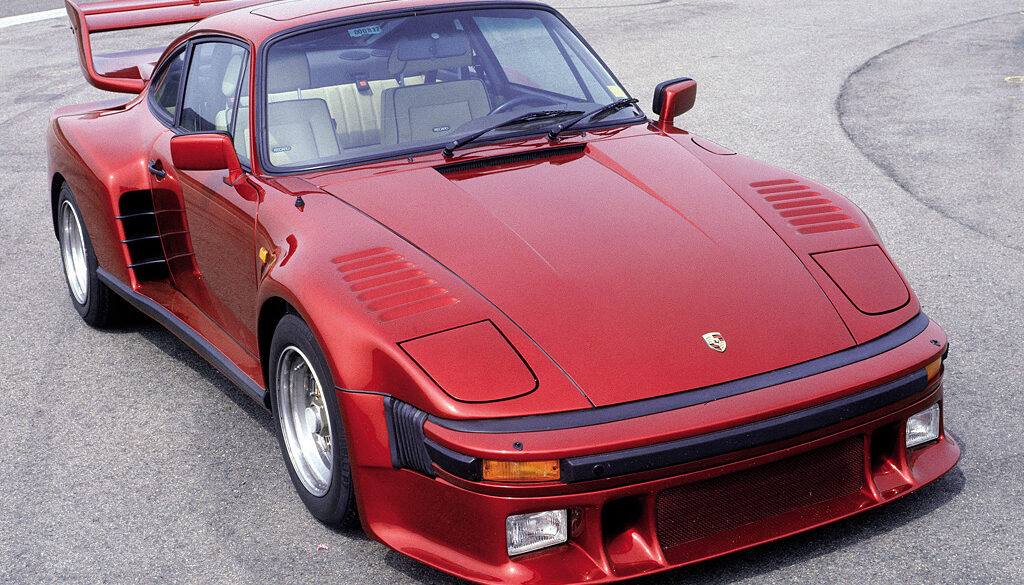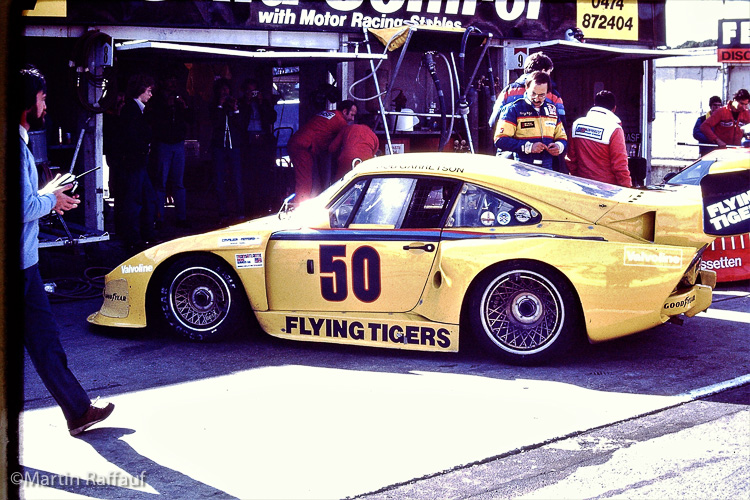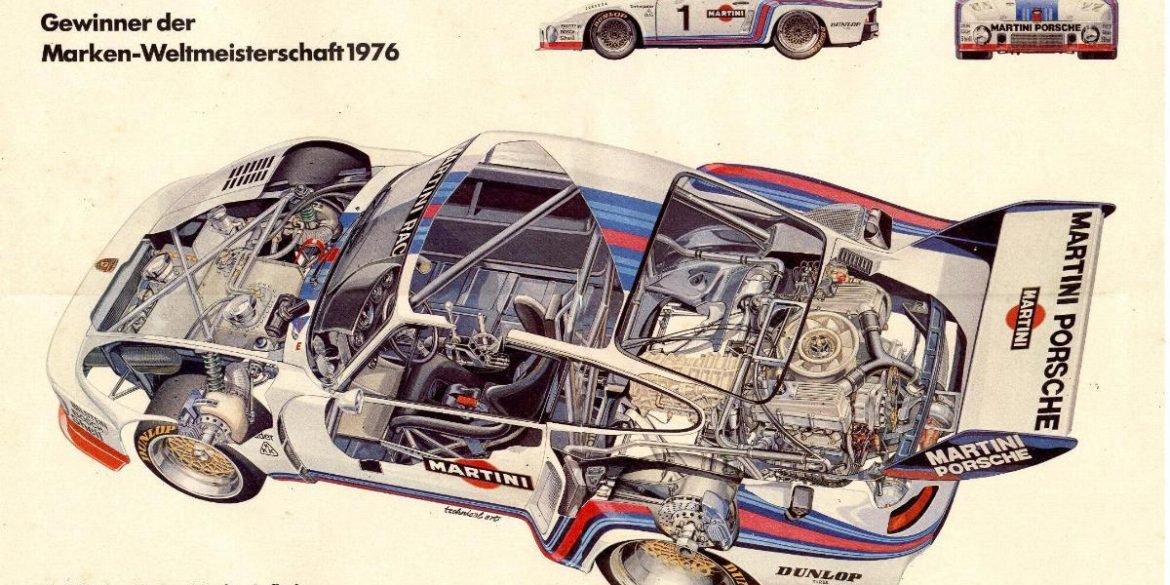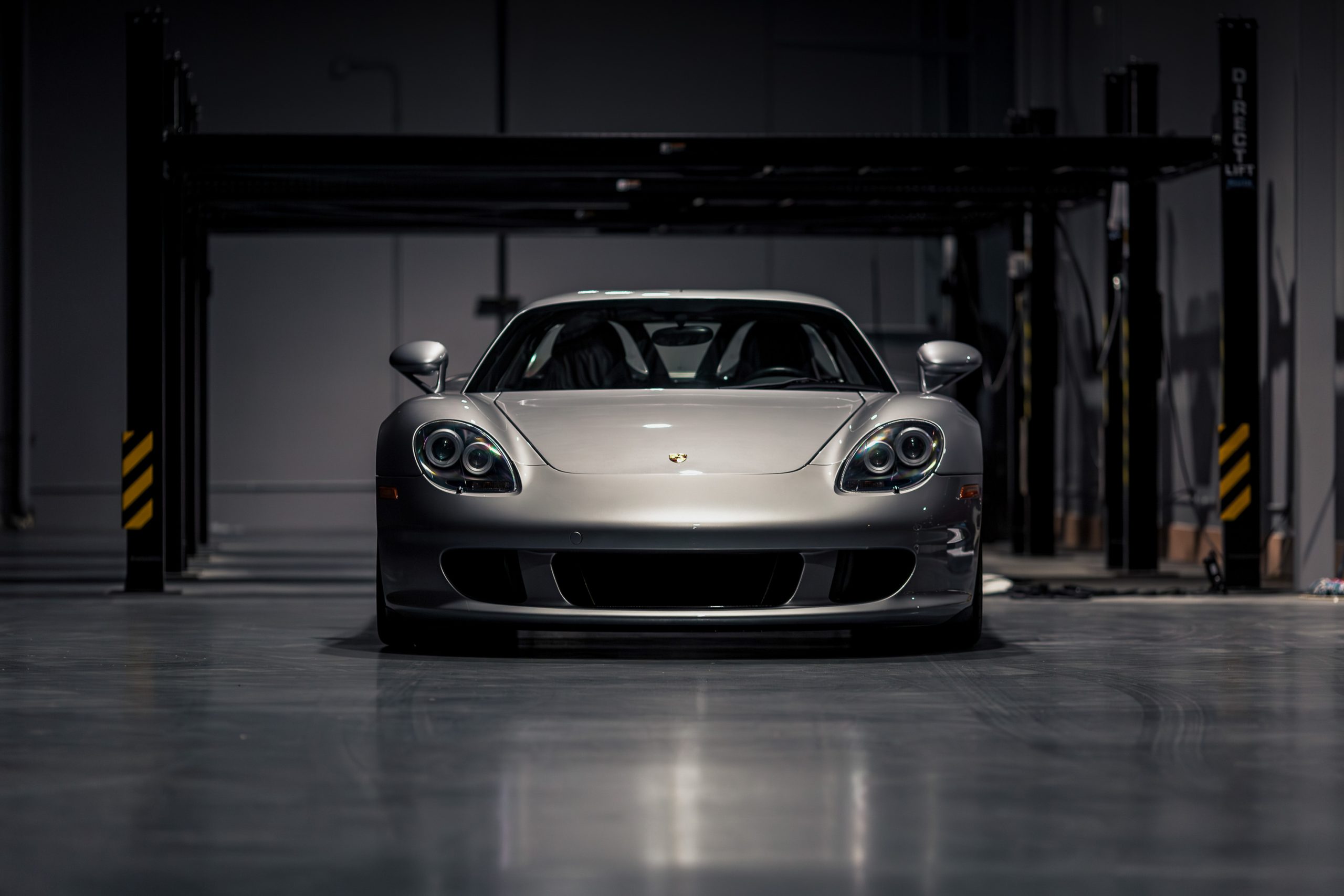The #6 Barbour, Stommelen, Mears car, a 935-78 (935-77A), enters the Sebring front straight. While this was the fastest car there, it was delayed for some laps with a brake issue and finished fourth The IMSA season in the 1970s always started with the two toughest races on the calendar,...
1976 Porsche 935 The history of 935-001, the first Porsche 935 ever built, originates in a major revision to the FIA’s Group 5 category. For the 1976 racing season, the FIA changed the rulebook to allow extensive modifications to production-based vehicles homologated in Groups 1 through 4. These “Special Production...
#5 Porsche 908/3 – Juan Fernandez/Francesco Torredemer/Eugenio Baturone – NRF The 1972 season broke, ushering in with it a new era of racing. The Porsche 917 had reigned supreme for two years, but the race authorities (read FIA) had had their fill of Porsche interpreting the rules their way, and...
As Rolf Stommelen climbed behind the wheel of the front-running Andial/Meister Porsche 935K3 after co-driver Derek Bell had pitted to refuel and take on four new tires, rising American star Bobby Rahal found himself leading Mid-Ohio’s $50,000-to-win “all-comers” Lumbermens 500 in the Group 6 Red Roof Inns Ralt RT-2 he...
In a garage full of legendary vehicles, one in particular stands out: the Porsche 935. The Porsche 935 was the first rear-engine race car to win the 24 Hours of Le Mans. On the occasion of the classic car’s centennial, we visited the 1979 winning vehicle in its current owner’s...
Porsche Special at Swiss Hillclimb In this video, he had the lucky chance to record both external and internal sounds and video of a restored 1976 Porsche 935/76 Group 5 race car. ...
930...
A huge banner adorns the side of this high bay warehouse in Werk 2, announcing the 25th anniversary exhibition of Exclusive from 1st March to 1st May 2011 Rolf Sprenger was a versatile engineer whose Porsche career was founded almost entirely on customer service. “If I want a trailer (caravan)...
Porsche 935 K3Turbo At Nürburgring In 1979 a 935 K3 was the overall winner of the 24h of Le Mans. A “normal” 935 came second and a 935 K2 came third overall. So it was an impressive car even back then. What are the differences between a K3 and a...
Porsche 935/2.0 ‘Baby’ Pictures...
No Subscription? You’re missing out Get immediate ad-free access to all our premium content. Get Started Already a Member? Sign in to your account here....
Porsche 935 k3 Kremer Turbo On Track ...
This 1982 Porsche DP 935 was specifically commissioned by a Porsche engineer for a feature in “Car and Driver” magazine, penned by Csaba Csere, in the publication’s 1984 Buyer Guide titled “DP 935 Fantasies Fulfilled: No Waiting.” The details of the build are substantiated by a confirmation letter from DP...
Brian Redman – Daring Drivers, Deadly Tracks © EVRO Publishing Brian Redman is about as down-to-earth as they come, which for a top-flite racing driver, is not an attribute common to all who ply their trade in this field. I have had the pleasure of interviewing Brian on twelve occasions...
Le Mans 24 Hours, 13-14 June 1981: Team photo following a successful technical inspection A lack of testing proved to be the downfall of the Porsche-Lola T600 in the 49th running of the Le Mans 24 Hours in 1981. But let us not get ahead of ourselves… The 1981 season...
Much of what Porsche learns in motor racing benefits the production models and thus the customers. The story of the sports car manufacturer is full of notable examples – clearly illustrated with turbo technology and the 24 Hours of Le Mans through to the new 911 Carrera GTS T-Hybrid. The...
The Complete Book of Porsche 911 – Every Model Since 1964 by Randy Leffingwell: © Quarto Publishing The name, Randy Leffingwell, will be familiar to most Porsche enthusiasts. Leffingwell worked in Kansas City, Chicago and for the LA Times as a photographer and writer for more than two decades. In...
Toine Hezemans in his Brussels home, 2015 One of the Netherlands’ most successful racers, Toine Hezemans is part of a motorsport dynasty that began with his father who raced Porsches in the 1950s. This family tradition continued with Toine who began racing 911s in the late ‘60s, but after his...
Yes, you might think the title is a mis- print, but it is not. HSR (Historic Sportscar Racing) put on their now annual Historic 24-hour race for vintage cars at Daytona International Speedway from 4-8 November. This event is run in a similar fashion to the Le Mans 24 historic...
This 2019 Porsche 935, listed on Bring a Trailer, is one of only 77 units produced as a tribute to the legendary 935 race car. Built exclusively for the track and not homologated for road use, it was introduced in 2018 during the Rennsport Reunion VI at Laguna Seca to...
Restored Porsche 935/76 Group 5 Car In this video, he had the lucky chance to record both external and internal sounds and video of a restored 1976 Porsche 935/76 Group 5 race car. ...
There are 935s, and then there are 935s… Although almost a hundred Porsche 935s were built between 1975 and 1984, with the factory building some forty two cars and customers building the remainder, JLP-4 was by far the most radical of the Group 5 breed. No Subscription? You’re missing out...
The 935/77 was a result of relaxed rules and the car got a completely new suspension. The mirrors were incorporated into the front fenders and the rear window had a new angle. The 935/77 was visually very pleasing. While the 935/76 had a single turbocharger, the 2.85-litre engine of the 935/77 had two turbochargers. There was also a "baby" 935/77 built with a smaller 1.4-litre turbocharged engine to compete in the national German DRM series under 2 liter class.
In 1982 Bob Akin Motor Racing commissioned spectacular Porsche 935 to be built for their Le Mans effort. It was built by Chuck Gaa of Gaaco to have a higher topspeed and increased performance. Chuck Gaa fitted a Lola T600 front end to a new bespoke bonded aluminum chassis. According to the regulations, the body retained the 930 roof structure, but was entirely new from the beltline down. The standard 3.2-liter Porsche engine was used and put out 750 bhp.
Porsche 935/77 Specifications This is the spec sheet for the Porsche 935/77. Note there was also a 1.4 Liter “Baby” Porsche 935 and those specs can be found here. No Subscription? You’re missing out Get immediate ad-free access to all our premium content. Get Started Already a Member? Sign in to...
In 1977 Kremer sufficiently improved the 935 to begin series production of their own version. It was the third Kremer built on Porsche’s successful platform and many 935/934s were updated to reflect ideas from the brothers in Cologne. The K3 version of their 935 was a great success and won...
Porsche 930 to 935: The Turbo Porsches – by John Starkey © Veloce Publishing Ltd Much has been written about Porsche’s racing exploits over the years, but there is perhaps one model that has served, more than any other, as the pillar of the company’s achievements. Prototypes have come and...
It may have taken place just over a week ago, but the Rolex Monterey Motorsports Reunion 2019 was another top-drawer event that should be celebrated for the manner in which it has lifted the profile of yesterday’s great race cars. The growth in historic race reunions, revivals, festivals and the...
In 1979, French cyclist Jean Claude Rude set out to break the world speed record for a bicycle. The previous record for a bicycle, set in 1962, belonged to his compatriot José Meiffret and was 204.7 km/h (127.2 mph). This speed was shown on the German autobahn near Freiburg, where...
Sports car racing went through some turbulent times in the early 1970’s. At the start (1970) the world championship was decided by the 5.0 liter sports cars such as the Porsche 917 and the Ferrari 512. The FIA /CSI (International rules body) at first did not think anyone would build...
Without any doubt, one of the most exciting classes or motor racing during the 1970s was the GT class, which included the Group 4 and Group 5 or ‘Silhouette’ classes. It wasn’t just the cars that were exciting, but the gallant combatants had character and guts, making this one of...
The Gerry Judah sculpture at the 2018 Goodwood Festival of Speed featured six Porsche cars mounted on a 52-metre-high star-shaped structure. This event celebrated both the 25th Festival of Speed as well as Porsche’s 70th anniversary I have always wondered, what the Goodwood FOS (Festival of Speed) was all about....
In 1977 Kremer sufficiently improved the 935 to begin series production of their own version. It was the third Kremer built on Porsche's successful platform and many 935/934s were updated to reflect ideas from the brothers in Cologne. The K3 version of their 935 was a great success and won the 1979 24 Hours of Le Mans, 1980 Sebring 12 Hours outright.
No Subscription? You’re missing out Get immediate ad-free access to all our premium content. Get Started Already a Member? Sign in to your account here....
Inspired by the Kremer brothers, Joest built their own version of the 935 for the 1979 season. Like the factory cars it featured intakes in the C-pillars and also had a slightly different front profile. One car was campaigned by Liqui Moly Joest Racing and won the 1980 Daytona 24 Hours outright as driven by Reinhold Jöst, Rolf Stommelen and Volkert Merl. A second car was built up for Electrodyne and raced with Momo livery in the USA.
Le Mans 24 Hours, 14-15 June 1969: On the final lap, the No. 64 Porsche 908 LH of Hans Herrmann/Gérard Larrousse swapped places with the No. 6 Ford GT40 of Jacky Ickx/Jackie Oliver as many as five times. The two cars were so evenly matched that what the Ford lacked...
The Porsche 935 K3 was constructed by German tuner, Kremer Racing, in accordance with Group 5 regulations. It is equipped with a flat six engine that was carried over from the factory built 935s, although in later years a slightly larger 3.2 litre engine was also offered. Depending on the...
The 935/78 was the ultimate expression of the 911 factory race car before Porsche officially withdrew from motor sport. Raced under the Group 5 silhouette series, great liberties were taken with the design and the result was nicknamed ‘Moby Dick’ for its large size and huge overhangs. The 935/78 was built under Porsche's Chief Racing by Norbert Singer for high speeds at Le Mans. Due to the advanced shape of the car 227 mph or 366 km/h was possible.
Porsche 935/77 “Baby” Specifications No Subscription? You’re missing out Get immediate ad-free access to all our premium content. Get Started Already a Member? Sign in to your account here....
John Fitzpatrick Group C Porsches – The Definitive History, Mark Cole. © Porter Press There seem to be a number of books entering the market right now on Porsche’s motor racing history. This is not a bad thing, because there is so much to explore about these fantastic and iconic...
This is the start/finish line and main grandstand Thursday’s qualifying at Daytona was a tense affair, with the top spot being snatched in the prototype and GTLM classes by the smallest of margins, in the closing stages of the session. Martin has sent a batch of interesting shots and we...
Le Mans 24 Hours, 31 May-1 June 1986: Start of the race – Porsches dominate the lead group In Part 1, Stories from Le Mans – with a Porsche flavour, our intrepid scribbler who hails from that beautiful part of South Africa, the Western Cape, shares with us some hilarious...
In the late 1970s, while Porsche’s 935 was dominating GT racing, the Kremer brothers, Manfred and Erwin, believed they could enhance the factory cars. Operating a Porsche dealership, Erwin raced Porsches tuned by Manfred. By 1977, Manfred began extensively modifying the cars, producing the 935 K2 in 1978, which rivaled...
Magnus Walker’s popular YouTube series, “Other Peoples Porsche,” explores unique and fascinating Porsche cars across the country. From a 1969 Porsche 911T in New York to a 1982 Porsche 930 Turbo in Miami, Magnus has already seen some remarkable examples from the German brand. In the newest episode of his...
It has been one year short of four decades since this 1980 Porsche 935 K3 was fabricated by Kremer Racing in Germany. Today this race car is every bit the race car it was intended to be back in the day – fearsome, awesome and very capable. It is powered...
Porsche & Le Mans Newly released “Racing with Giants” video features archival footage of Le Mans past and present, along with interviews with multiple drivers and Porsche team principals, including Allan McNish, Patrick Long, Jacky Ickx and Nick Tandy. Porsche has long competed at Le Mans, though recently solely in...
As we wave goodbye to 2018 and usher in a brand-new year, we look back on the top ten favourites that we were privileged to publish in the last twelve months. We have decided to bring you our top 10 from 2018 (in chronological order) to show you, our valued...
Bob Akin’s 935, one of the major protagonists in the 1983 Sebring 12 Hour race. It was driven by Bob Akin, John O’Steen and Dale Whittington and finished second overall. (©Brian Cleary) The 1983 Sebring 12 Hour was an epic event. Back then the race was run on the ‘old...
Le Mans 24 Hour, 13-14 June 2015: Lined up prior to the formation lap are (from L-R) – the #18 Porsche 919 Hybrid driven by Marc Lieb/Romain Dumas/Neel Jani (finished 5th); #17 Porsche 919 Hybrid driven by Timo Bernhard/Brendon Hartley/Mark Webber (finished 2nd); #19 Porsche 919 Hybrid driven by Earl...
Le Mans 24 Hour, 10/11 June 1978: The Porsche 935/78 ‘Moby Dick’ pulls away at the start of the race – this car was third fastest in qualifying Dick Barbour went to Le Mans as an entrant for the first time in 1978. He entered two Porsche 935s at the...
Kremer Porsche 935 K3/80 (chassis #0013) In the mid-70s, Porsche developed the 935 model, a race car homologated on the 930 road car and aimed at the Group 5 ‘silhouette’ series created by the FIA for the 1976 season. As the records will show, the 935 was a formidable race...
12 Hours of Sebring, 18 March 1978: The #9 Dick Barbour Racing Porsche 935 driven by Brian Redman, Charles Mendez and Bob Garretson In the early to mid-1970’s I had been working part time (race weekends) as an IMSA tech inspector at some of the races, mainly the ones that...
DP Motorsport is a German tuning company that came to prominence in the late 1970’s when they partnered with the Kremer brothers racing team. They started out as a supplier and manufacturer of various body parts such as rear wings, fenders, etc. The relationship between DP Motorsport and the racing...
A great video to listen to the soundtrack of the 6-cylinder 2.9-L bi-turbo engine of the Porsche 935/77 Turbo. Turn up the volume and enjoy this pure ASMR goodness!...
Porsche 935 Turbo Monster + Onboard I had the pleasure of filming this amazing Porsche 935 k3 Kremer Gr.5 during the 2020 Monza Historic. We have to thank the pilot Jean-Marc Merlin and all the guys from Team Equipe Europe for being very kind to us and let to install...
1981 Porsche Kremer 935 K4 – chassis #K4-01 In the mid-1970s, Porsche developed the 911 for racing, and in the process, it created the all-conquering 935. In 1978, Norbert Singer was responsible for building the ultimate factory 935, the Moby Dick 935/78, and although this race car had a very...
Using factory 935/78 ‘Moby Dick’ plans, Kremer built their own version. In doing so they modified the body to their own design to include more downforce. Only two cars were built in K4 specification. Bob Wollek drove the first car to win the Porsche Cup in 1981. Later this car was sold to John Fitzpatrick Racing and driven by John Fitzpatrick and David Hobbs to many successes in the IMSA series.
Background Since the 1960s, Porsche has been optimizing the aerodynamics of future racing and production vehicles in the wind tunnel with the help of special miniature models. The example of the legendary Porsche 935/78 shows how this works. Model vehicles feature in many a display case as diminutive dream cars....
Porsche 935-78 Moby Dick (chassis 935/78.006 ), photographed at the Porsche Warehouse in May 2017 Group 5 rules offered manufacturers a great deal of freedom to modify their cars in the Silhouette class. At Porsche, Norbert Singer pushed the rules to the limit, and gave us the Porsche 935/78 Moby...
The #8 Kremer K3 Porsche 935 entered by Dick Barbour and driven by John Fitzpatrick, in the pit lane ahead of the 1980 Norisring race. The author, Martin Raffauf, is at the car’s right front wheel The Race for the Pork Cutlets… The end of June 1980 was a busy...
Porsche 935 On Track ...
The Porsche 928 was launched in 1978 – this is a 1980 model The Porsche company, now 30 years old in 1978, had moved from being the small-scale manufacturing company to being a significant player, albeit in a niche market. The front-engined transaxle 924 model, introduced in 1976, was now...
No Subscription? You’re missing out Get immediate ad-free access to all our premium content. Get Started Already a Member? Sign in to your account here....
Upon seeing the factory 935s and what was possible using the 930 platform, the Kremer bothers from Cologne built up their own version. Their first car contested the World Championship of Makes in 1976 and in the following year, an updated version known as the K2 was further modified. Compared to the Porsche 935, the Kremer version was much more slab sided and featured fences along the top of the rear fender to direct air to the rear wing.
The 935/78 was the ultimate expression of the 911 factory race car before Porsche officially withdrew from motor sport. Raced under the Group 5 silhouette series, great liberties were taken with the design and the result was nicknamed ‘Moby Dick’ for its large size and huge overhangs. Only one 935/78...
It’s hard to know where to begin when writing a report on Porsche Rennsport Reunion VI. It was both an emotional and a sensory overload! A reunion with people not seen for a while, and the historical impact of all the rare cars. This was the sixth iteration put on...
A few years ago, an unlikely vehicle listing appeared online by Cartique – a luxury car dealer from Germany. The listing in question is for a 1979 Porsche 935 Kremer K3. Today, we are sharing it with you all as our car of the day. Porsche revived the iconic 935...
The 1977 #40 Martini Porsche 935/2.0 Baby (chassis #935 2 001) photographed at the Porsche Museum, Stuttgart, Germany in May 2017 Ernst Fuhrmann’s requirement to develop a significantly updated GT race car in 1977, would present a number of challenges for the Porsche race department. Just to make things interesting,...
The #91 Porsche 911 RSR driven by Richard Lietz and Frederic Makowiecki rounds Malmedy during the WEC 6 Hours of Spa-Francorchamps on 6 May 2017 Sixty-six years ago, on 24 June 1951, the first Porsche was pushed tentatively onto the starting grid of the 1951 Le Mans 24 Hour race....
Porsche’s sixth edition of the by now much-anticipated Rennsport Reunion kicked off on Wednesday 26 September 2018. You could have expected that this would be a really big one for Porsche, with it being their 70th anniversary year, but the Stuttgart manufacturer really pushed the boat out with this one....
Official Daytona ’85 poster By 1981 at the earliest, and for sure by the 1983 season of sports car racing, it had become clear to most that the Porsche 935 was reaching the end of its useful racing life. While it had been a great car, it just could not...
In 1983 Porsche produced a stunning one-of road car for TAG owner Mansour Ojjeh. Based on a 934 chassis, it was designed to mimic the potent 935 racecars and subsequently became the one of the first slantnoses. Both the front and rear sections were made similar to the potent 935 race car which dominated the Group 5 Championship. This silhouette series allowed radical modifications which contributed to the repositioned nose, ultra-wdie flares and extended rear bodywork.
Porsche 935 JLP-4 at the Goodwood Festival of Speed, 2014 JLP-4 was the final race car in the line of Porsche 935 specials built for the John Paul father and son team. Using this final ‘weapon’, the Pauls notched up several outright victories in IMSA races and, in combination with...
Daytona 24 Hours, 31 January/1 February 1981: Bob Garretson, Bobby Rahal and Brian Redman driving the #9 Porsche 935 (chassis #009 00030) would go on to win the race by 13 laps, having started from 16th on the grid The Flying Tigers strike again! Being the best on the planet in...
No Subscription? You’re missing out Get immediate ad-free access to all our premium content. Get Started Already a Member? Sign in to your account here....


